Brother Innov-is 4000D, Innov-is 4000DLTD Operation Manual
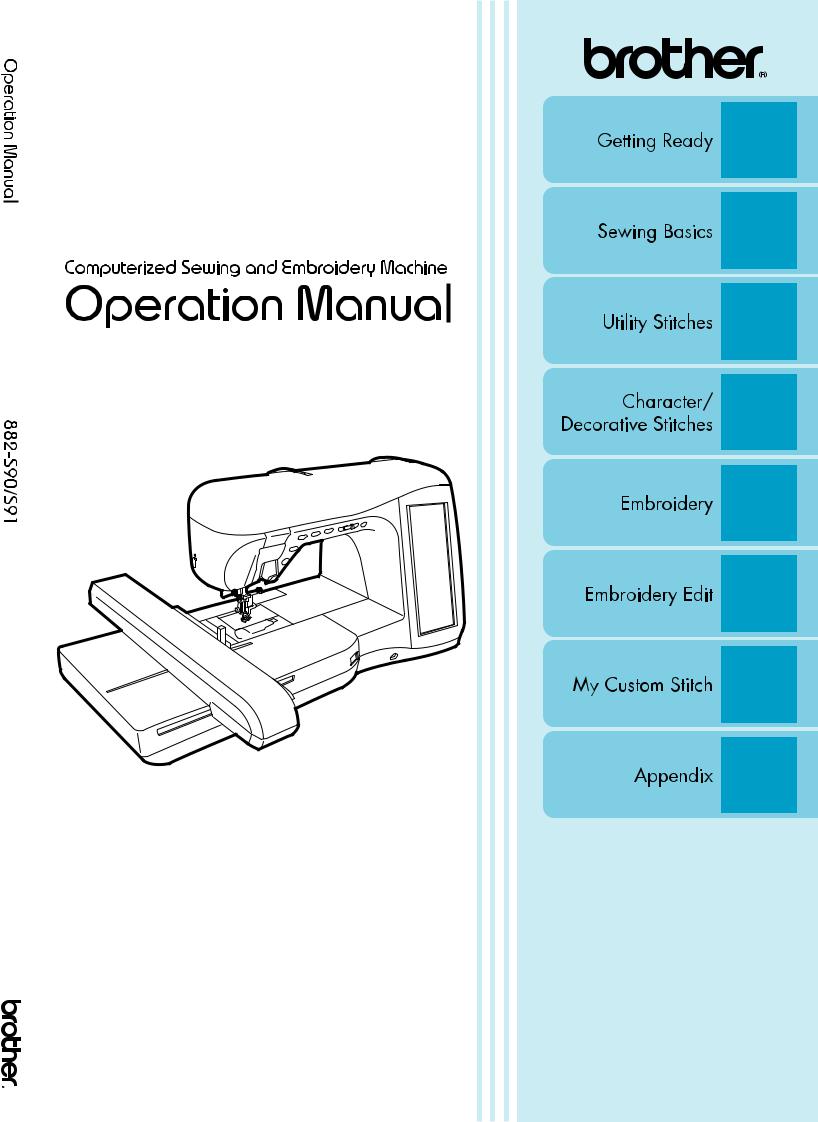
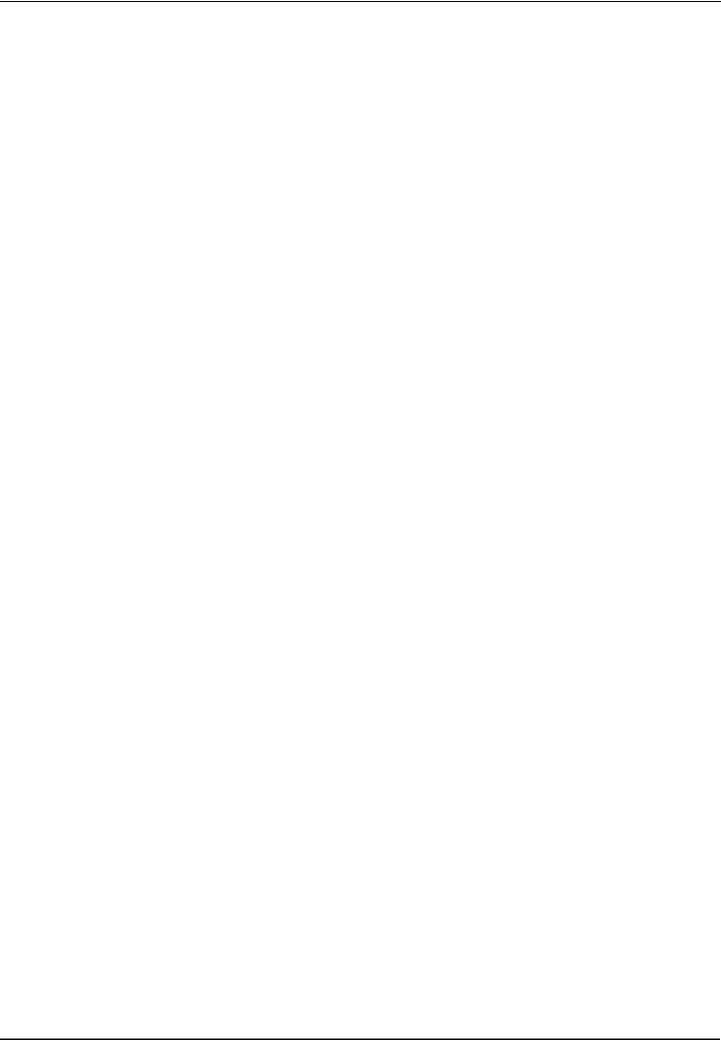
IMPORTANT SAFETY INSTRUCTIONS
When using this machine, basic safety precautions should always be taken, including the following: Read all instructions before using.
DANGER - To reduce the risk of electric shock:
1.The machine should never be left unattended while plugged in. Always unplug the machine from the electrical outlet immediately after using and before cleaning.
WARNING - To reduce the risk of burns, fire, electric shock, or injury to persons:
1.Do not allow this machine to be used as a toy. Close attention is necessary when the machine is used by or near children.
2.Use this machine only for its intended use as described in this manual. Use only accessories recommended by the manufacturer as contained in this manual.
3.Never operate this machine if it has a damaged cord or plug, if it is not working properly, if it has been dropped or damaged, or dropped into water. Return the machine to the nearest authorized dealer or service center for examination, repair, electrical or mechanical adjustment.
4.Never operate the machine with any air openings blocked. Keep ventilation openings of the machine and foot control free from the accumulation of lint, dust, and loose cloth.
5.Never drop or insert any object into any opening.
6.Do not use outdoors.
7.Do not operate where aerosol (spray) products are being used or where oxygen is being administered.
8.To disconnect, turn the main switch to the symbol “ ” position which represents off, then remove plug from outlet.
” position which represents off, then remove plug from outlet.
9.Do not unplug by pulling on cord. To unplug, grasp the plug, not the cord.
10.Keep fingers away from all moving parts. Special care is required around the machine needle.
11.Always use the proper needle plate. The wrong plate can cause the needle to break.
12.Do not use bent needles.
13.Do not pull or push fabric while stitching. It may deflect the needle causing it to break.
14.Switch the machine to the symbol “ ” position when making any adjustments in the needle area, such as threading needle, changing needle, threading bobbin, or changing presser foot, and the like.
” position when making any adjustments in the needle area, such as threading needle, changing needle, threading bobbin, or changing presser foot, and the like.
15.Always unplug the machine from the electrical outlet when removing covers, lubricating, or when making any other user servicing adjustments mentioned in the instruction manual.
16.This sewing machine is not intended for use by young children or infirm persons without supervision.
17.Young children should be supervised to ensure that they do not play with this machine.
18.If the light unit is damaged, it must be replaced by authorized dealer.
19.Hold the foot controller plug when rewinding into cord reel. Do not allow the plug to whip when rewinding.
SAVE THESE INSTRUCTIONS
This machine is intended for household use.
i
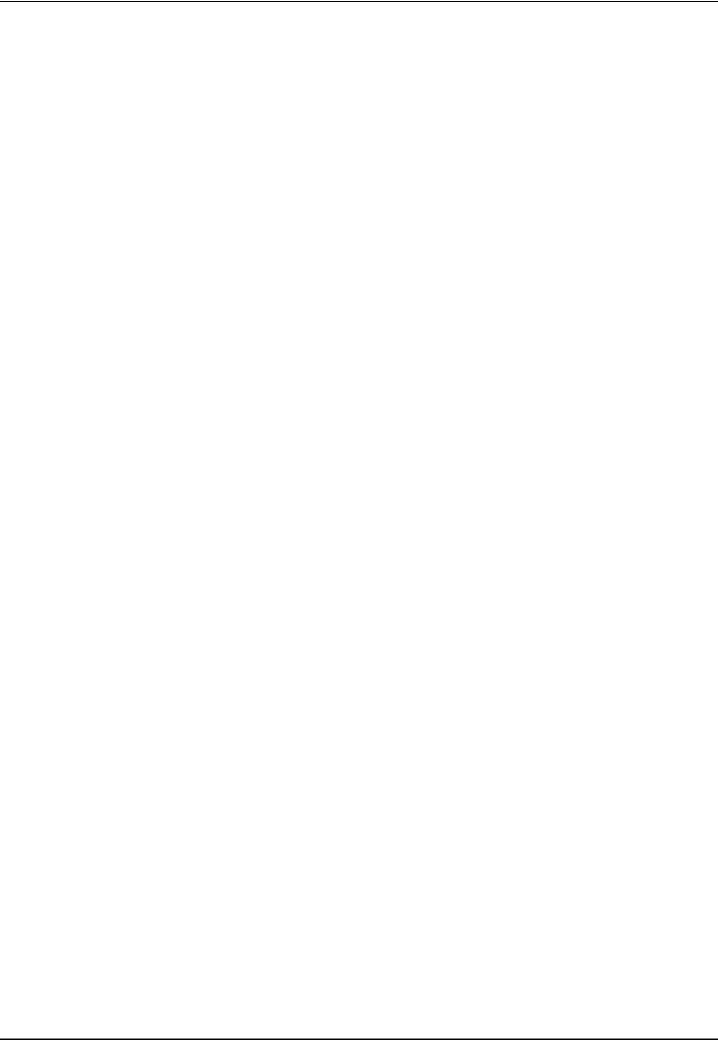
FOR USERS IN THE UK, EIRE, MALTA
AND CYPRUS ONLY
If this machine is fitted with a three-pin non-rewireable BS plug then please read the following.
IMPORTANT
If the available socket outlet is not suitable for the plug supplied with this equipment, it should be cut off and an appropriate three-pin plug fitted. With alternative plugs an approved fuse must be fitted in the plug.
NOTE
The plug served from the main lead must be destroyed as a plug with bared flexible cords is hazardous if engaged in a live socket outlet. In the event of replacing the plug fuse, use a fuse approved by ASTA to BS 1362, i.e. carrying
the mark, rating as marked on plug.
mark, rating as marked on plug.
Always replace the fuse cover, never use plugs with the fuse cover omitted.
WARNING
DO NOT CONNECT EITHER WIRE TO THE EARTH TERMINAL WHICH IS MARKED WITH THE LETTER ‘E’, BY THE EARTH SYMBOL OR COLOURED GREEN OR GREEN AND YELLOW.
OR COLOURED GREEN OR GREEN AND YELLOW.
The wires in this main lead are coloured in accordance with the following code:
Blue Neutral
Brown Live
As the colours of the wiring in the main lead of this appliance may not correspond with the coloured markings identifying the terminals in your plug, proceed as follows.
The wire which is coloured blue must be connected to the terminal which is marked with the letter ‘N’ or coloured black or blue.
The wire which is coloured brown must be connected to the terminal which is marked with the letter ‘L’ or coloured red or brown.
ii
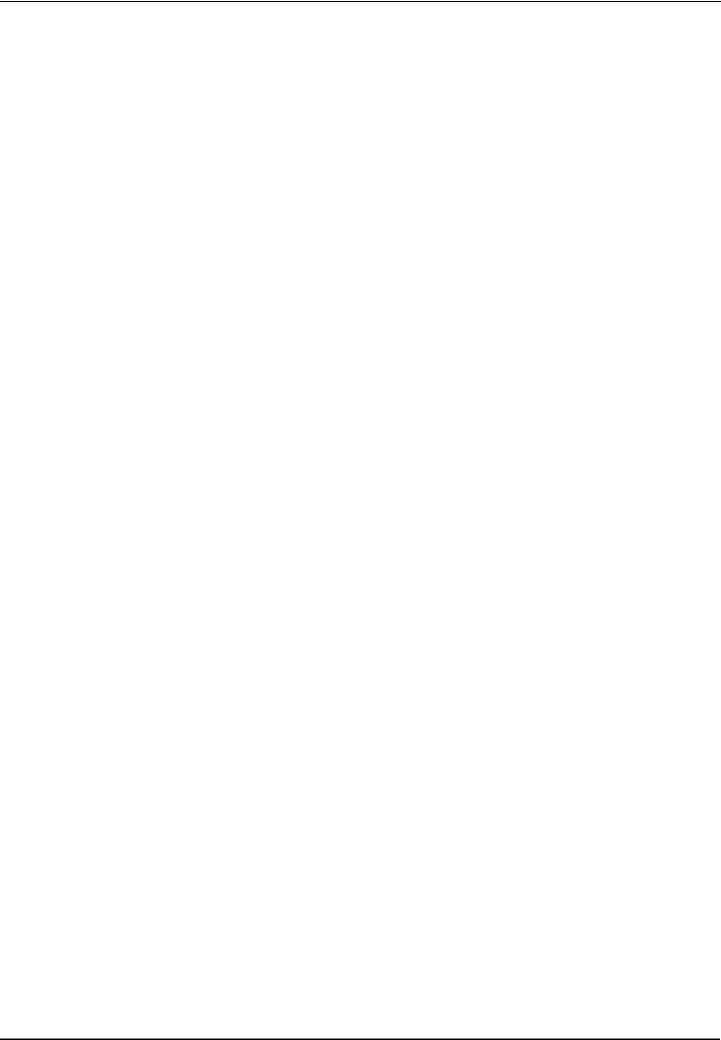
Federal Communications Commission (FCC)
Declaration of Conformity (For USA Only)
Responsible Party: Brother International Corporation
100 Somerset Corporate Boulevard
Bridgewater, NJ 08807-0911 USA
TEL : (908) 704-1700
declares that the product
Product Name: |
Brother Sewing Machine |
Model Number: |
Innov-ís 4000D/NV4000D |
complies with Part 15 of the FCC Rules. Operation is subject to the following two conditions: (1) this device may not cause harmful interference, and (2) this device must accept any interference received, including interference that may cause undesired operation.
This equipment has been tested and found to comply with the limits for a Class B digital device, pursuant to Part 15 of the FCC Rules. These limits are designed to provide reasonable protection against harmful interference in a residential installation. This equipment generates, uses, and can radiate radio frequency energy and, if not installed and used in accordance with the instructions, may cause harmful interference to radio communications. However, there is no guarantee that interference will not occur in a particular installation. If this equipment does cause harmful interference to radio or television reception, which can be determined by turning the equipment off and on, the user is encouraged to try to correct the interference by one or more of the following measures:
•Reorient or relocate the receiving antenna
•Increase the separation between the equipment and receiver.
•Connect the equipment into an outlet on a circuit different from that to which the receiver is connected.
•Consult the dealer or an experienced radio/TV technician for help.
•The enclosed interface cable should be used in order to ensure compliance with the limits for a Class B digital device.
•Changes or modifications not expressly approved by Brother Industries, Ltd. could void the user's authority to operate the equipment.
iii
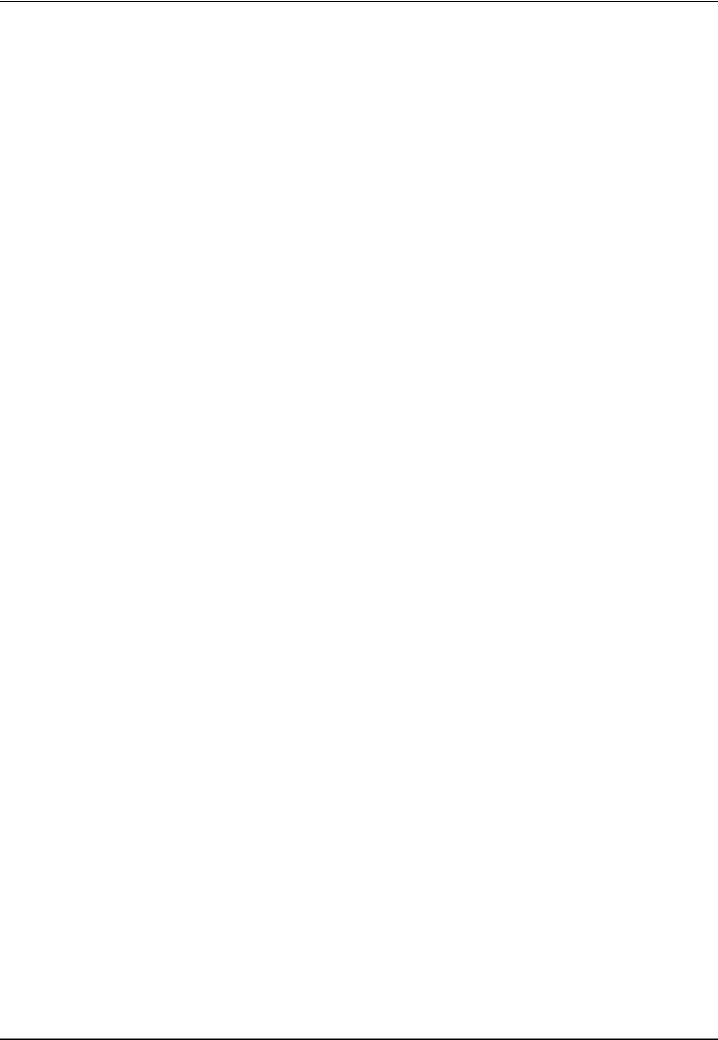
CONGRATULATIONS ON CHOOSING OUR
MACHINE
Your machine is the most advanced computerized household embroidery and sewing machine. To fully enjoy all the features incorporated, we suggest that you study the manual.
PLEASE READ BEFORE USING THIS MACHINE
For safe operation
1.Be sure to keep your eye on the needle while sewing. Do not touch the handwheel, thread take-up, needle, or other moving parts.
2.Remember to turn off the power switch and unplug the cord when:
•Operation is completed
•Replacing or removing the needle or any other parts
•A power failure occurs during use
•Maintaining the machine
•Leaving the machine unattended.
3.Do not store anything on the foot controller.
4.Plug the machine directly into the wall. Do not use extension cords.
For a longer service life
1.When storing this machine, avoid direct sunlight and high humidity locations. Do not use or store the machine near a space heater, iron, halogen lamp, or other hot objects.
2.Use only neutral soaps or detergents to clean the case. Benzene, thinner, and scouring powders can damage the case and machine, and should never be used.
3.Do not drop or hit the machine.
4.Always consult the operation manual when replacing or installing any assemblies, the presser feet, needle, or other parts to assure correct installation.
For repair or adjustment
In the event a malfunction occurs or adjustment is required, first follow the troubleshooting table in the back of the operation manual to inspect and adjust the machine yourself. If the problem persists, please consult your local authorized Brother dealer.
For additional product information and updates, visit our web site at www.brother.com
The contents of this manual and specifications of this product are subject to change without notice.
iv
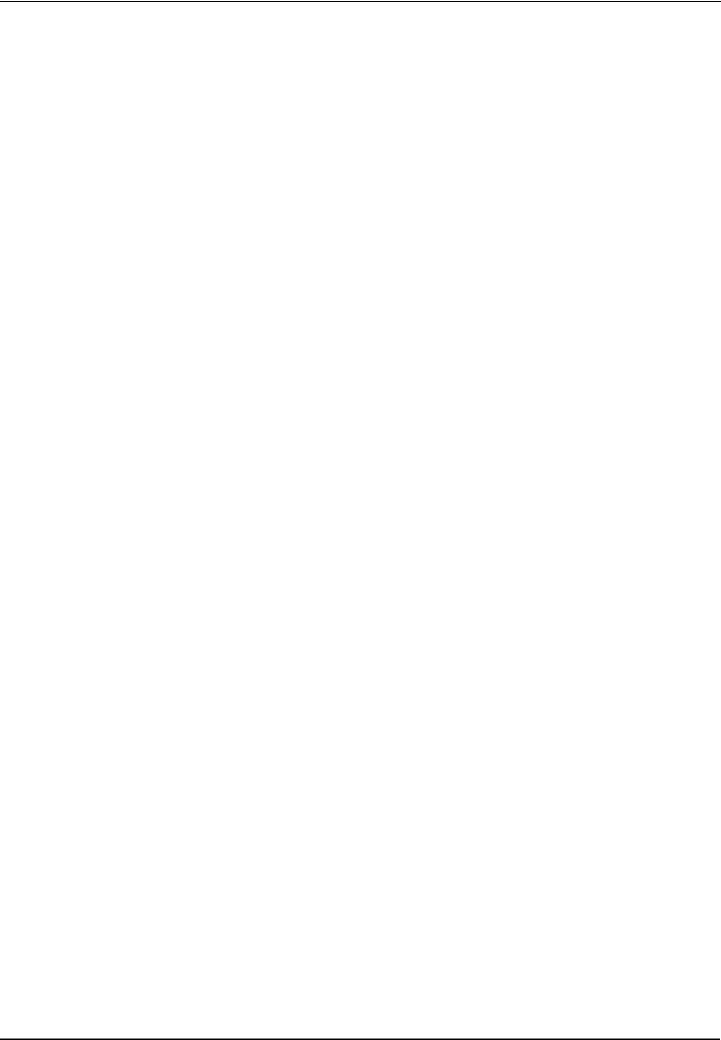
v
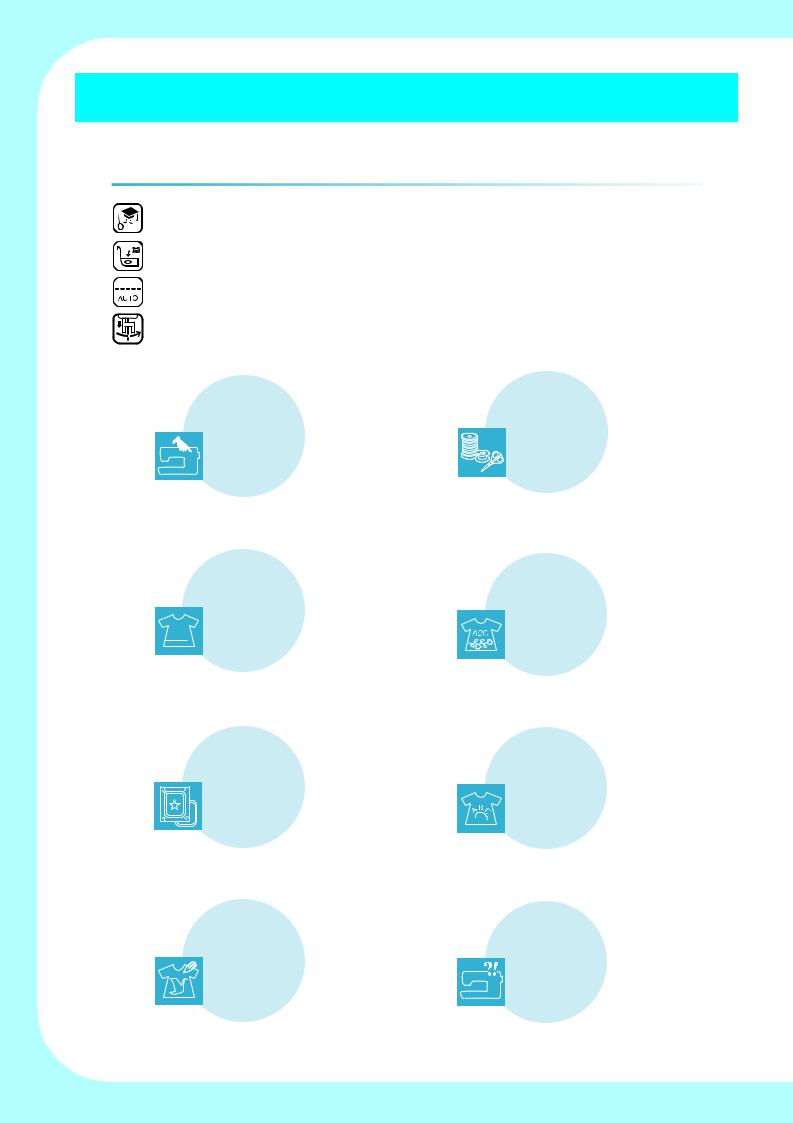
WHAT YOU CAN DO WITH THIS MACHINE
SPECIAL FEATURES
Check operations and view advice on the large LCD (liquid crystal display).
Prepare the bobbin thread with one touch.
The automatic thread tension makes trial sewing unnecessary.
Automatic threading makes threading quick and easy.
Getting Ready
To learn the operation of the principal parts and the screens
Chapter 1
Page 7
Utility Stitches
Pre-programmed with more than 100 frequently used stitches
Chapter 3
Page 47
Embroidery
Maximum 30 cm x 18 cm (approx. 12 x 7 inches) for large embroidery designs
Chapter 5
Page 125
My Custom Stitch
Create original decorative stitches
Chapter 7
Page 199
Sewing Basics
To learn how to prepare for sewing and basic sewing operations
Chapter 2
Page 37
Character/Decorative
Stitches
The variety of stitches widen your creativity
Chapter 4
Page 97
Embroidery Edit
Designs can be combined, rotated or enlarged
Chapter 6
Page 175
Appendix
Caring for your machine and dealing with errors and malfunctions
Chapter 8
Page 209
vi
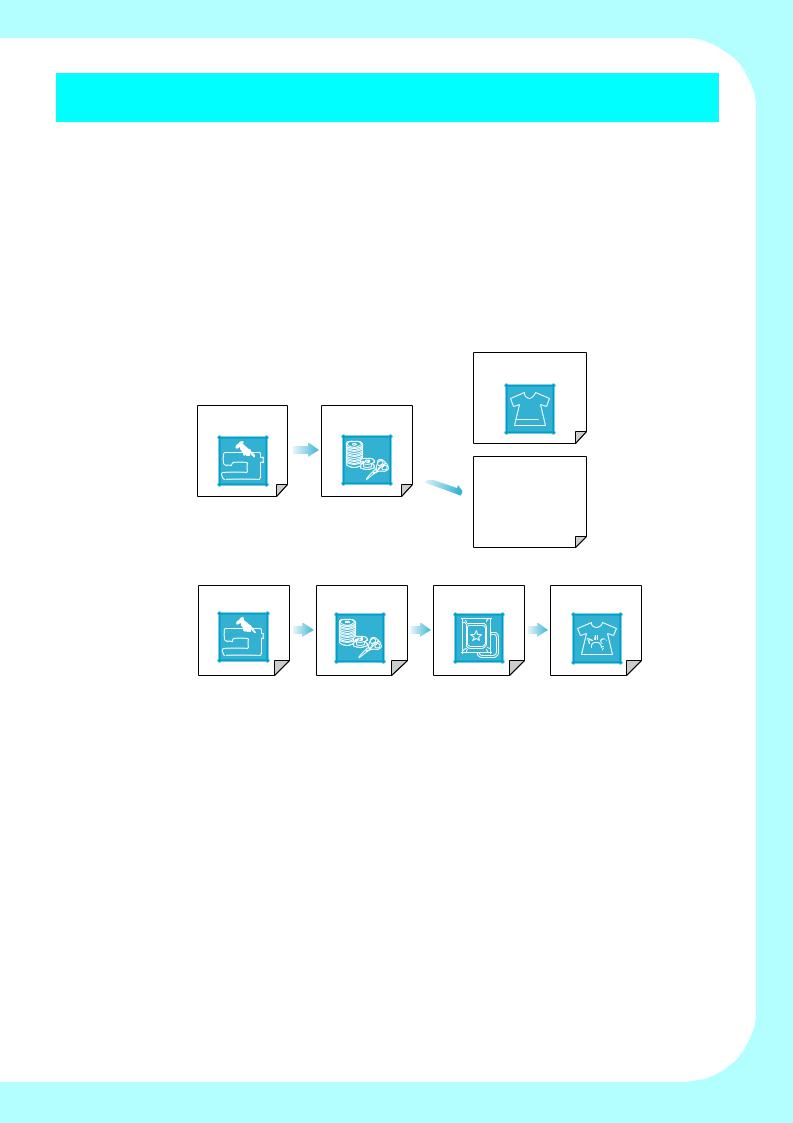
HOW TO USE THIS MANUAL
Chapter 1 and Chapter 2 explain your sewing machine’s basic operation procedures for someone who is using the sewing machine for the first time. If you want to sew utility stitches or character/ decorative stitches, read Chapter 1 and Chapter 2, then go on to Chapter 3 (Utility Stitches) or Chapter 4 (Character/ Decorative Stitches).
When you are ready to begin using the embroidery function after reading Chapter 1 and Chapter 2, proceed to Chapter 5 (Embroidery). Once you understand the steps explained in Chapter 5, go on to Chapter 6 (Embroidery Edit) for an explanation about the convenient embroidery edit functions.
In the screens that appear in the step-by-step directions the parts that are used for the operation are shown in  . Compare the screen in the directions with the actual screen, and carry out the operation.
. Compare the screen in the directions with the actual screen, and carry out the operation.
If, while using the machine, you experience something you do not understand, or there is a function you would like to know more about, refer to the index at the back of the operation manual in conjunction with the table of contents to find the section of the manual you should refer to.
To sew utility stitches To sew character or decorative stitches
Chapter 3
Chapter 1 Chapter 2 
Chapter 4
|
|
|
|
|
Chapter 1 |
Chapter 2 |
Chapter 5 |
Chapter 6 |
|
To do machine embroidery
vii
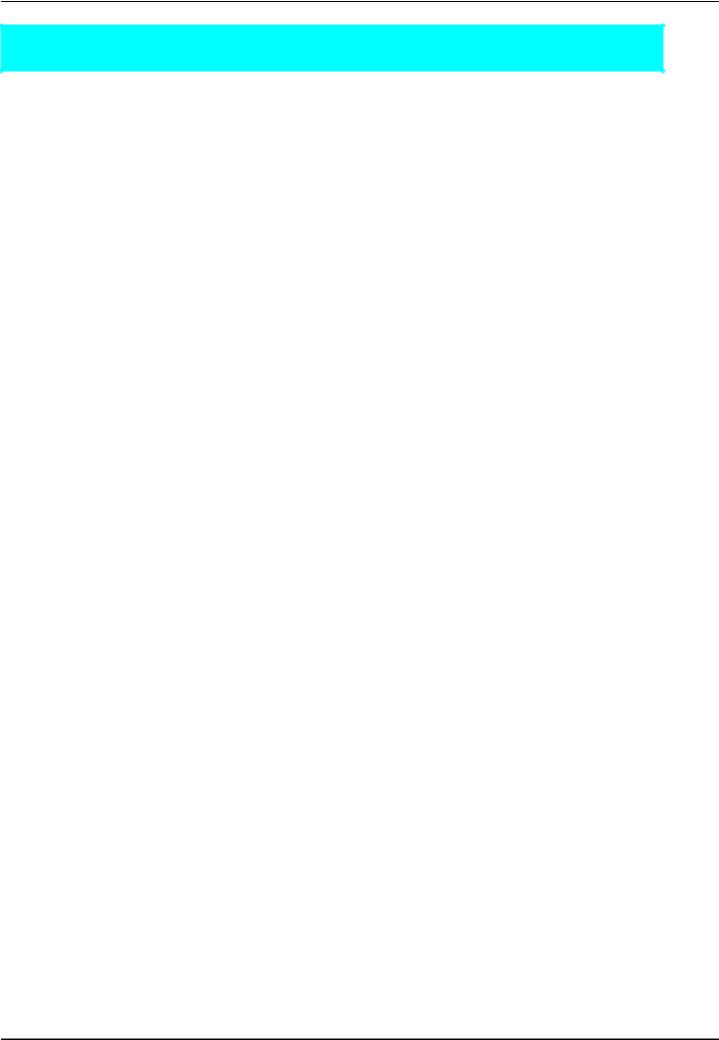
Contents
CONTENTS
IMPORTANT SAFETY INSTRUCTIONS .................. |
i |
WHAT YOU CAN DO WITH THIS MACHINE..... |
vi |
HOW TO USE THIS MANUAL ............................ |
vii |
NAMES OF MACHINE PARTS AND THEIR |
|
FUNCTIONS ......................................................... |
1 |
Machine ................................................................................. |
1 |
Needle and Presser Foot Section ............................................. |
2 |
Embroidery Unit ..................................................................... |
2 |
Operation Buttons................................................................... |
3 |
Included Accessories .............................................................. |
3 |
Options................................................................................... |
6 |
Chapter 1 Getting Ready |
7 |
TURNING THE MACHINE ON/OFF ..................... |
8 |
LCD SCREEN ......................................................... |
9 |
Using the Machine Setting Mode Key .................................. |
12 |
Using the Machine Operation Mode Key .............................. |
17 |
Using the Pattern Explanation Key ........................................ |
18 |
LOWER THREADING.......................................... |
19 |
Winding the Bobbin.............................................................. |
19 |
Setting the Bobbin................................................................. |
22 |
Pulling Up the Bobbin Thread............................................... |
23 |
UPPER THREADING ........................................... |
25 |
Threading Using the “Automatic Threading” Button.............. |
25 |
Threading Manually .............................................................. |
27 |
Using the Twin Needle Mode .............................................. |
29 |
Using Threads that Unwind Quickly ..................................... |
31 |
CHANGING THE PRESSER FOOT ....................... |
32 |
Removing the Presser Foot .................................................... |
32 |
Attaching the Presser Foot ..................................................... |
32 |
Attaching the Walking Foot................................................... |
33 |
CHANGING THE NEEDLE................................... |
34 |
Chapter 2 Sewing Basics |
37 |
SEWING .............................................................. |
38 |
Sewing a Stitch ..................................................................... |
38 |
Sewing Reinforcement Stitches ............................................ |
40 |
Sewing Curves ...................................................................... |
40 |
Changing Sewing Direction ................................................. |
40 |
Sewing Heavyweight Fabrics ............................................... |
41 |
Sewing Lightweight Fabrics .................................................. |
41 |
STITCH SETTINGS .............................................. |
42 |
Setting the Stitch Width......................................................... |
42 |
Setting the Stitch Length ....................................................... |
42 |
Setting the Thread Tension ................................................... |
43 |
USEFUL FUNCTIONS.......................................... |
44 |
Automatic Reinforcement Stitching ...................................... |
44 |
Automatic Thread Cutting ..................................................... |
45 |
Locking the Screen ............................................................... |
46 |
Appliqué .............................................................................. |
73 |
Shelltuck Stitches ................................................................. |
74 |
Scallop Stitches .................................................................... |
75 |
Top Stitching ......................................................................... |
75 |
Smocking Stitches ................................................................ |
76 |
Fagoting ............................................................................... |
76 |
Tape or Elastic Attaching ...................................................... |
77 |
Heirloom .............................................................................. |
78 |
One-step Buttonholes ........................................................... |
80 |
Four-step Buttonholes............................................................ |
84 |
Bar Tacks ............................................................................. |
88 |
Button Sewing ...................................................................... |
90 |
Eyelet ................................................................................... |
92 |
Multi-directional Sewing (Straight Stitch and Zigzag Stitch) |
..93 |
Zipper Insertion .................................................................... |
94 |
Chapter 4 Character/Decorative Stitches |
97 |
SELECTING STITCH PATTERNS.......................... |
98 |
Selecting Decorative Stitch Patterns/7mm Decorative Stitch |
|
Patterns/Satin Stitch Patterns/7mm Satin Stitch Patterns/Cross |
|
Stitch/Utility Decorative Stitch Patterns ............................... |
100 |
Alphabet Characters ........................................................... |
100 |
SEWING STITCH PATTERNS ........................... |
102 |
Sewing Attractive Finishes .................................................. |
102 |
Basic Sewing ....................................................................... |
102 |
Making Adjustments ........................................................... |
103 |
EDITING STITCH PATTERNS ........................... |
105 |
Changing the Size ............................................................... |
106 |
Changing the Length (for 7mm Satin Stitch Patterns Only) .. |
107 |
Creating a Vertical Mirror Image ........................................ |
107 |
Creating a Horizontal Mirror Image .................................... |
107 |
Sewing a Pattern Continuously ........................................... |
107 |
Changing Thread Density |
|
(for Satin Stitch Patterns Only) ............................................ |
108 |
Checking the Image............................................................. |
108 |
COMBINING STITCH PATTERNS .................... |
110 |
Before Combining ............................................................... |
110 |
Combining Various Stitch Patterns ...................................... |
110 |
Combining Large and Small Stitch Patterns ......................... |
112 |
Combining Horizontal Mirror Image Stitch Patterns ............ |
112 |
Combining Stitch Patterns of Different Length ..................... |
113 |
Making Step Stitch Patterns |
|
(for 7mm Satin Stitch Patterns Only) ................................... |
114 |
USING THE MEMORY FUNCTION .................. |
116 |
Stitch Data Precautions ....................................................... |
116 |
Saving Stitch Patterns in the Machine’s Memory ................. |
118 |
Saving Stitch Patterns to USB Media |
|
(Commercially Available) .................................................... |
120 |
Saving Stitch Patterns in the Computer ................................ |
121 |
Retrieving Stitch Patterns from the Machine’s Memory ........ |
122 |
Recalling from USB Media .................................................. |
123 |
Recalling from the Computer............................................... |
124 |
Chapter 3 Utility Stitches |
47 |
SELECTING UTILITY STITCHES |
..........................48 |
Selecting a Stitch................................................................... |
48 |
Saving Your Stitch Settings ................................................... |
50 |
Using the Sewing Type Selection Key .................................. |
51 |
SEWING THE STITCHES ..................................... |
53 |
Straight Stitches..................................................................... |
53 |
Dart Seam ............................................................................. |
57 |
Gathering.............................................................................. |
57 |
Flat Fell Seam ....................................................................... |
58 |
Pintuck ................................................................................. |
59 |
Zigzag Stitches ..................................................................... |
60 |
Elastic Zigzag Stitches .......................................................... |
62 |
Overcasting ......................................................................... |
63 |
Quilting ............................................................................... |
67 |
Blind Hem Stitches .............................................................. |
72 |
Chapter 5 Embroidery |
125 |
BEFORE EMBROIDERING................................. |
126 |
Embroidery Step by Step ..................................................... |
126 |
Attaching Embroidery Foot “W” ......................................... |
127 |
Attaching the Embroidery Unit ........................................... |
128 |
SELECTING PATTERNS .................................... |
130 |
Selecting Embroidery Patterns/Heirloom Patterns/Border |
|
Patterns/Cross stitch Patterns/Floral alphabet Patterns .......... |
132 |
Selecting Alphabet Character Patterns ................................. |
133 |
Selecting Frame Patterns ..................................................... |
134 |
Selecting Patterns from Embroidery Cards .......................... |
135 |
Selecting Patterns from USB media/Computer ..................... |
135 |
VIEWING THE SEWING SCREEN ..................... |
136 |
PREPARING THE FABRIC ................................. |
138 |
Attaching Iron-on Stabilizers (backing) to the Fabric ........... |
138 |
viii
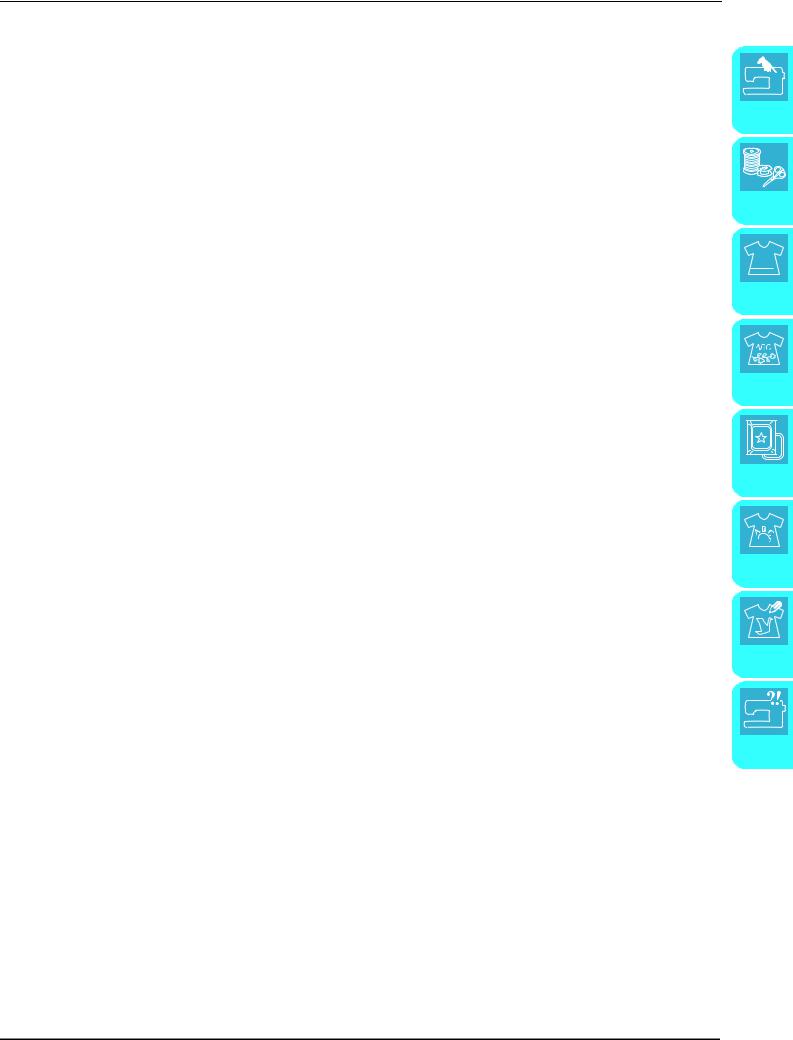
Contents
Hooping the Fabric in the Embroidery Frame ..................... |
139 |
Embroidering Small Fabrics or Fabric Edges ....................... |
141 |
ATTACHING THE EMBROIDERY FRAME.......... |
143 |
CONFIRMING THE PATTERN POSITION ........ |
144 |
Checking the Pattern Position ............................................. |
144 |
Previewing the Completed Pattern ...................................... |
145 |
SEWING AN EMBROIDERY PATTERN ............. |
146 |
Sewing Attractive Finishes .................................................. |
146 |
Sewing Embroidery Patterns ................................................ |
147 |
Sewing Embroidery Patterns Which Use Appliqué .............. |
148 |
ADJUSTMENTS DURING THE EMBROIDERY |
|
PROCESS .......................................................... |
150 |
If the Bobbin Runs Out of Thread ....................................... |
150 |
If the Thread Breaks During Sewing .................................... |
151 |
Restarting from the Beginning ............................................. |
152 |
Resuming Embroidery After Turning Off the Power ............. |
152 |
Chapter 7 MY CUSTOM STITCH |
199 |
DESIGNING A STITCH .................................... |
200 |
ENTERING STITCH DATA ............................... |
202 |
USING STORED CUSTOM STITCHES............... |
207 |
Storing Custom Stitches in Your List.................................... |
207 |
Retrieving Stored Stitches.................................................... |
208 |
Chapter 8 Appendix |
209 |
CARE AND MAINTENANCE ............................. |
210 |
Cleaning the LCD Screen ................................................... |
210 |
Cleaning the Machine Casing ............................................ |
210 |
Cleaning the Race............................................................... |
210 |
ADJUSTING THE SCREEN ................................ |
212 |
Screen Visibility is Low....................................................... |
212 |
Touch Panel is Malfunctioning ........................................... |
212 |
MAKING EMBROIDERY ADJUSTMENTS ......... |
154 |
Adjusting Thread Tension ................................................... |
154 |
Using the Automatic Thread Cutting Function |
|
(END COLOR TRIM) ........................................................... |
155 |
Using the Thread Trimming Function (JUMP STITCH TRIM) 155 |
|
Adjusting the Embroidery Speed ......................................... |
156 |
Changing the Thread Color Display..................................... |
157 |
Changing the Embroidery Frame Display ............................ |
158 |
REVISING THE PATTERN ................................. |
159 |
Changing the Pattern Position ............................................. |
159 |
Aligning the Pattern and the Needle .................................... |
159 |
Changing the Size ............................................................... |
160 |
Rotating the Pattern ............................................................. |
161 |
Creating a Horizontal Mirror Image .................................... |
162 |
Changing the Density (Alphabet Character |
|
and Frame Patterns Only) ................................................... |
162 |
Changing the Colors of Alphabet Character Patterns ........... |
163 |
USING THE MEMORY FUNCTION .................. |
164 |
Embroidery Data Precautions .............................................. |
164 |
Saving Embroidery Patterns in the Machine’s Memory ........ |
166 |
Saving Embroidery Patterns to USB Media (Commercially |
|
Available)............................................................................ |
168 |
Saving Embroidery Patterns in the Computer ....................... |
169 |
Retrieving Patterns from the Machine’s Memory ................. |
170 |
Recalling from USB Media .................................................. |
170 |
Recalling from the Computer............................................... |
171 |
EMBROIDERY APPLICATIONS ......................... |
173 |
Using a Frame Pattern to Make an Appliqué (1) .................. |
173 |
Using a Frame Pattern to Make an Appliqué (2) .................. |
174 |
TROUBLESHOOTING ...................................... |
214 |
ERROR MESSAGES ........................................... |
217 |
SPECIFICATIONS.............................................. |
223 |
UPGRADING YOUR MACHINE’S SOFTWARE. 224 |
|
Upgrade Procedure Using USB Media ................................ |
224 |
Upgrade Procedure Using Computer .................................. |
224 |
STITCH SETTING CHART ................................. |
227 |
INDEX............................................................... |
234 |
Chapter 6 Embroidery Edit |
175 |
EXPLANATION OF FUNCTIONS ..................... |
176 |
SELECTING PATTERNS TO EDIT ...................... |
177 |
Selecting Embroidery Patterns/Heirloom Patterns/Border |
|
Patterns/Cross stitch Patterns/Floral Alphabet Patterns/Frame |
|
Patterns ............................................................................... |
178 |
Selecting Alphabet Character Patterns ................................. |
178 |
EDITING PATTERNS ......................................... |
181 |
Moving the Pattern ............................................................. |
183 |
Rotating the Pattern ............................................................ |
183 |
Changing the Size of the Pattern ......................................... |
184 |
Deleting the Pattern ............................................................ |
185 |
Changing the Configuration of Alphabet Character Patterns 185 |
|
Changing Alphabet Character Spacing ............................... |
185 |
Changing the Color of Each |
|
Alphabet Character in a Pattern .......................................... |
186 |
Changing the Thread Color ................................................ |
187 |
Creating a Custom Thread Table ......................................... |
188 |
Choosing a Color from the Custom Thread Table ................ |
189 |
Designing Repeated Patterns ............................................... |
190 |
After Editing ........................................................................ |
194 |
COMBINING PATTERNS................................... |
195 |
Editing Combined Patterns .................................................. |
195 |
Sewing Combined Patterns.................................................. |
197 |
USING THE MEMORY FUNCTION................... |
198 |
1
2
3
4
5
6
7
8
ix
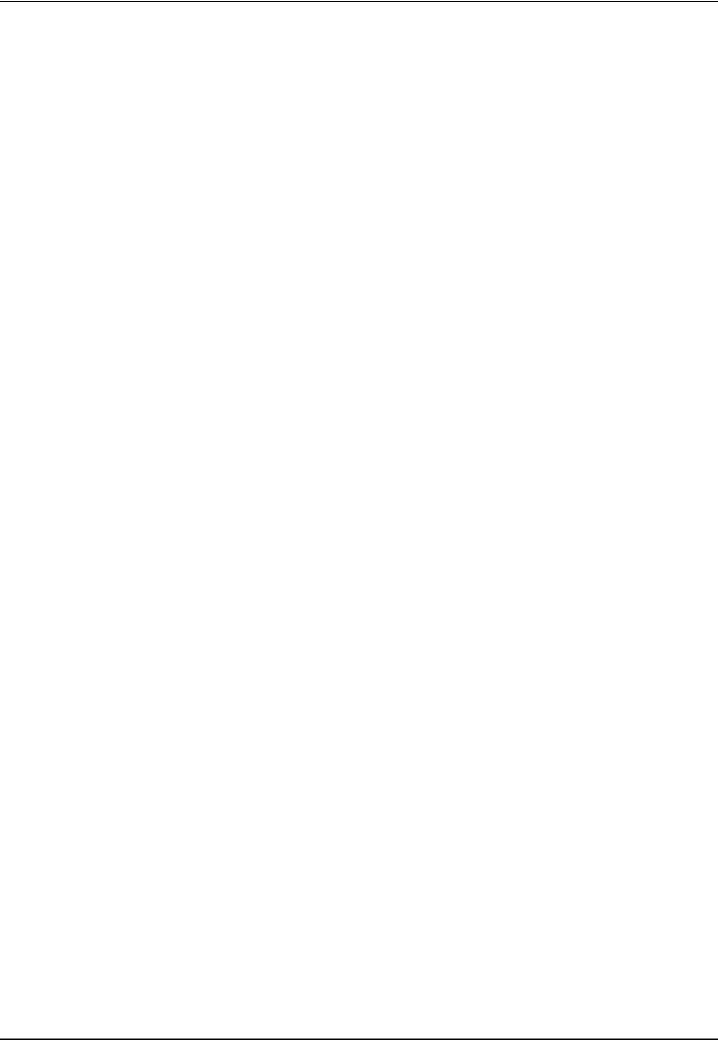
Contents
x
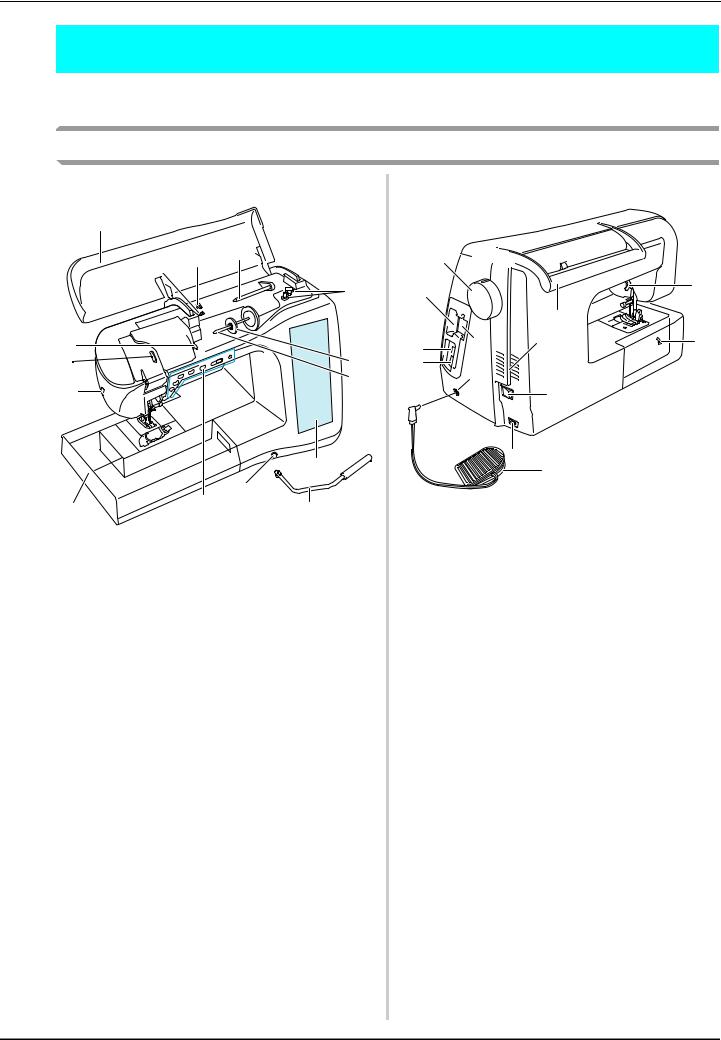
NAMES OF MACHINE PARTS AND THEIR FUNCTIONS
NAMES OF MACHINE PARTS AND THEIR FUNCTIONS
The names of the various parts of the sewing machine and their functions are described below. Before using the sewing machine, carefully read these descriptions to learn the names of the machine parts.
Machine
■ Front View
aa |
|
|
|
n |
ml |
on |
m |
|
|
|
|
|
|
lk |
i |
|
|
h |
|
|
c |
|
ji |
|
|
kj |
b |
|
|
|
|
hg |
|
|
fe |
dc |
ed |
gf |
|
aTop cover
Open the top cover to thread the machine and wind the bobbin.
bThread cutter
Pass the threads through the thread cutter to cut them.
cThread take-up lever check window
Look through the window to check the upper thread passing through in it.
dFlat bed attachment with accessory compartment
Store presser feet and bobbins in the accessory compartment of the flat bed attachment. When sewing cylindrical pieces, remove the flat bed attachment.
eOperation buttons (6 buttons) and sewing speed controller
Use these buttons and the slide to operate the sewing machine.
fKnee lifter slot
Insert the knee lifter into the slot.
gKnee lifter
Use the knee lifter to raise and lower the presser foot.
hLCD (liquid crystal display)
Settings for the selected stitch and error messages appear in the LCD.
iThread guide plate
Pass the thread around the thread guide plate when threading upper thread.
jSpool cap
Use the spool cap to hold the spool in place.
kSpool pin
Place a spool of thread on the spool pin.
lBobbin winder
Use the bobbin winder when winding the bobbin.
mSupplemental spool pin
Use this spool pin to wind the bobbin thread, or to sew with the twin needle.
nThread guide for bobbin winding
Pass the thread around this thread guide when winding the bobbin thread.
oPretension disk
Pass the thread around the pretension disk when winding the bobbin thread.
■ Right-side/Rear View
b 
j
c
|
|
|
a |
|
f |
k |
i |
d |
|
||
|
|
|
|
e |
m |
|
|
|
|
|
|
|
|
|
g |
h
l
aHandle
Carry the sewing machine by its handle when transporting the machine.
bHandwheel
Turn the handwheel toward you to raise and lower the needle. The wheel should be turned toward the front of the machine.
cEmbroidery card slot
Insert the embroidery cards (sold separately) into the embroidery card slot.
dUSB port connector for media
In order to send patterns from/to USB media, plug the USB media directly into the USB port connector.
eUSB port connector for computer
In order to import/export patterns between a computer and the machine, plug the USB cable into the USB port connector.
fTouch pen holder
Use the touch pen holder to hold the touch pen when not in use.
gMain power switch
Use the main power switch to turn the sewing machine ON and OFF.
hJack connector
Insert the power cord into the connector jack.
iFeed dog position switch
Use the feed dog position switch to lower the feed dogs.
jPresser foot lever
Raise and lower the presser foot lever to raise and lower the presser foot.
kAir vent
The air vent allows the air surrounding the motor to circulate. Do not cover the air vent while the sewing machine is being used.
lFoot controller with retractable cord
Depress the foot controller to control the speed of the machine.
mFoot controller jack
Insert the foot controller plug into its jack on the machine.
1
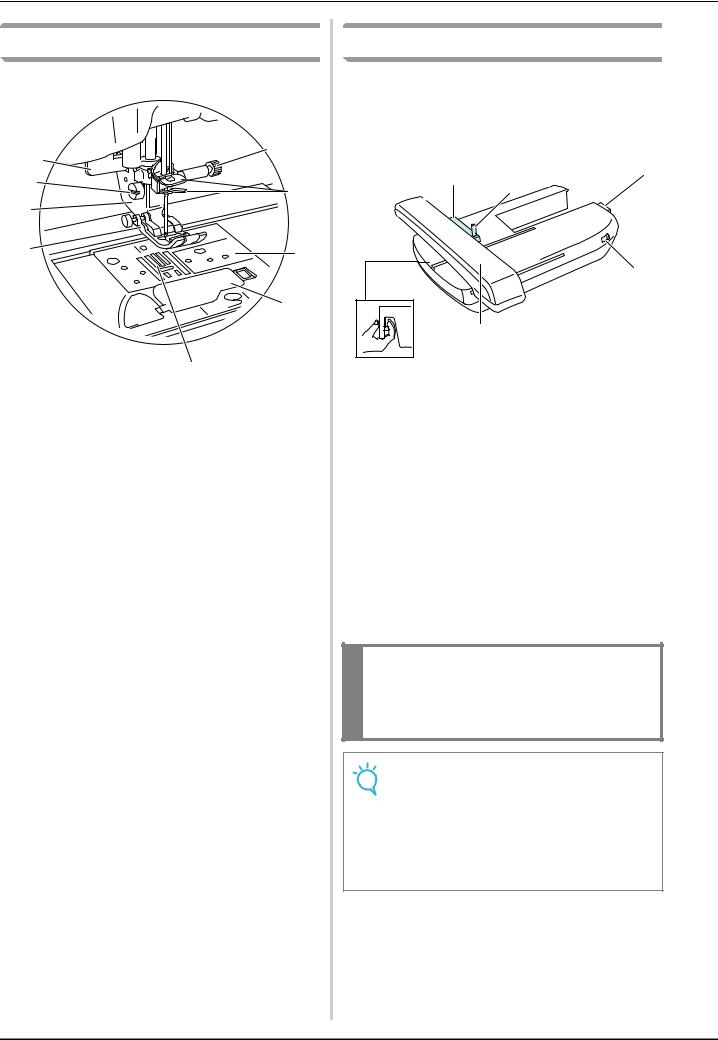
NAMES OF MACHINE PARTS AND THEIR FUNCTIONS
Needle and Presser Foot Section
e
f |
|
i |
g |
|
|
a |
|
b |
h |
|
|
|
d |
c
aPresser foot holder
The presser foot is attached onto the presser foot holder.
bPresser foot
The presser foot applies pressure consistently on the fabric as sewing takes place. Attach the appropriate presser foot for the selected stitch.
cFeed dogs
The feed dogs feed the fabric in the sewing direction.
dBobbin cover
Open the bobbin cover to set the bobbin.
eNeedle clamp screw
Use the needle clamp screw to hold the needle in place.
fButtonhole lever
The buttonhole lever is used with the one-step buttonhole foot to create buttonholes.
gNeedle bar thread guides
Pass the upper thread through the two needle bar thread guides.
hNeedle plate
The needle plate is marked with guides to help sew straight seams.
iPresser foot holder screw
Use the presser foot holder screw to hold the presser foot in place.
Embroidery Unit
e
d
f
c
b
a
aCarriage
The carriage moves the embroidery frame automatically when embroidering.
bRelease button (located under the embroidery unit)
Press the release button to remove the embroidery unit.
cFeed dog position switch
Use the feed dog position switch to raise and lower the feed dogs while the embroidery unit is attached.
dEmbroidery unit connection
Insert the embroidery unit connection into the connection port when attaching the embroidery unit.
eEmbroidery frame holder
Insert the embroidery frame into the embroidery frame holder to hold the frame in place.
fFrame-securing lever
Press the frame-securing lever down to secure the embroidery frame.
 CAUTION
CAUTION
•After the embroidery frame is set in the frame holder, be sure the frame-securing lever is correctly lowered.
Note
•Be sure that the feed dog position switch on the embroidery unit is located at right when embroidering.
•You can also sew utility/decorative stitches with the embroidery unit attached. Set the feed dog position switch on the embroidery unit to the appropriate setting.
2
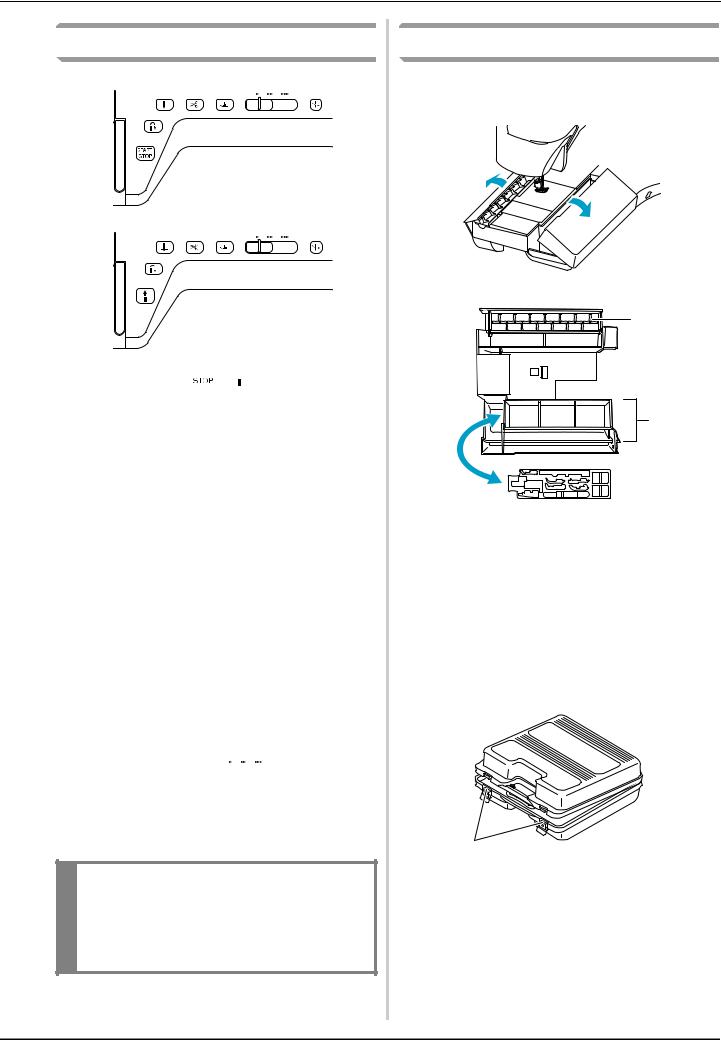
NAMES OF MACHINE PARTS AND THEIR FUNCTIONS
Operation Buttons
a“Start/Stop” button 

Press this button and the machine will sew a few stitches at a slow speed and then begin sewing at the speed set by the sewing speed controller. Press the button again to stop the machine. Hold the button in to sew at the machine’s slowest speed. The button changes color according to the machine’s operation mode.
Green: |
the machine is ready to sew or is sewing. |
Red: |
the machine cannot sew. |
b“Reverse/Reinforcement Stitch” button
Use this button to sew reinforcement stitches at the beginning and end of sewing. Press this button, and the machine sews 3 stitches in the same spot and stops automatically. For straight and zigzag stitch patterns that take reverse stitches, the machine will sew reverse stitches at low speed only while holding down the “Reverse/Reinforcement Stitch“ button (the stitches are sewn in the opposite direction).
c“Needle Position” button 
Use this button when changing sewing direction or for detailed sewing in small areas. Press this button to raise or lower the needle position. Press the button twice to sew a single stitch.
d“Thread Cutter” button
Press this button after sewing to automatically trim the excess thread.
e“Presser Foot Lifter” button 
Press this button to lower the presser foot and apply pressure to the fabric. Press this button again to raise the presser foot.
fSewing Speed controller 
Use this controller to adjust the sewing speed. Move the slide to the left to sew at slower speeds. Move the slide to the right to sew at higher speeds. Beginners should sew at a slow speed.
g“Automatic Threading” button 
Use this button to automatically thread the needle.
 CAUTION
CAUTION
•Do not press the thread cutter button after the threads have already been cut. Otherwise, the needle may break, the threads may become tangled, or damage to the machine may occur.
Included Accessories
Pull the top of the flat bed attachment to open the accessory compartment.
a
b
 c
c
aStorage space
bPresser foot storage space
cPresser foot storage space
Included Accessories 31-34 are contained in the embroidery unit carrying case. To open the embroidery unit carrying case, unhook the two latches on the case. To re-hook the latches and securely close the case, press on the latches until each of them clicks.
a
a Latches
3
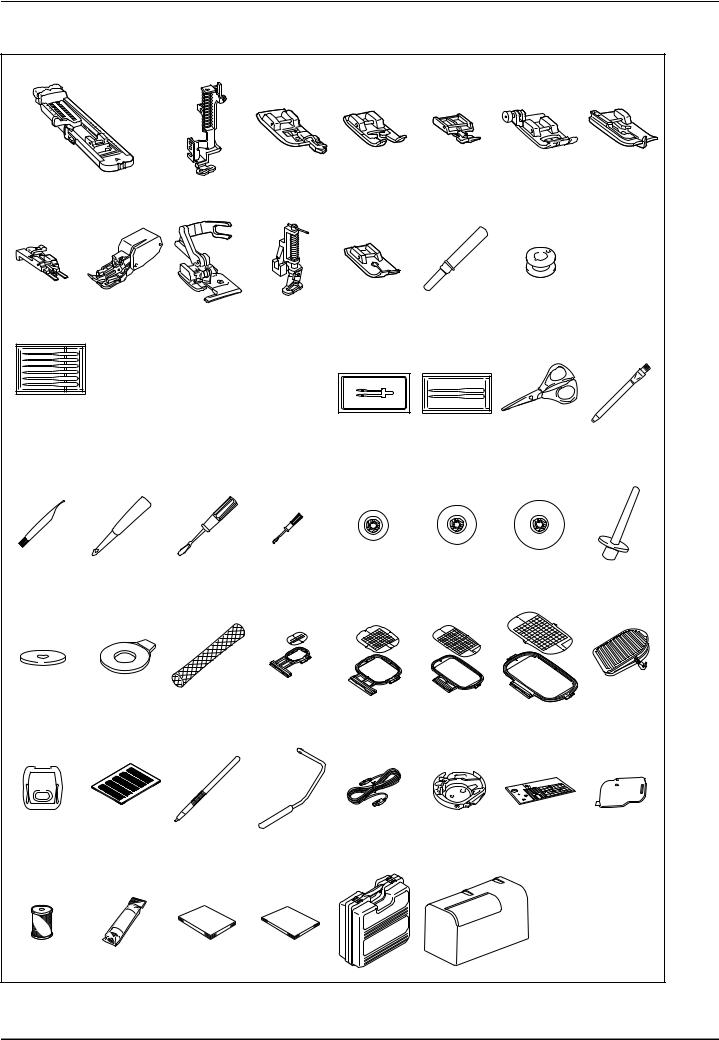
NAMES OF MACHINE PARTS AND THEIR FUNCTIONS
→ Included Accessories
1 |
2 |
3 |
4 |
5 |
6 |
7 |
8 |
9 |
10 |
11 |
12 |
13 |
14 |
15 |
16 |
17 |
18 |
19 |
75/11 2 needles 90/14 2 needles
90/14 2 needles: Ball point needle (gold colored)
20 |
21 |
22 |
23 |
24 |
25 |
26 |
27 |
28 |
29 |
30 |
31 |
32 |
33 |
34 |
35 |
36 |
37 |
38 |
39 |
40 |
41 |
42 |
43 |
44 |
45 |
46 |
47 |
48 |
49 |
4
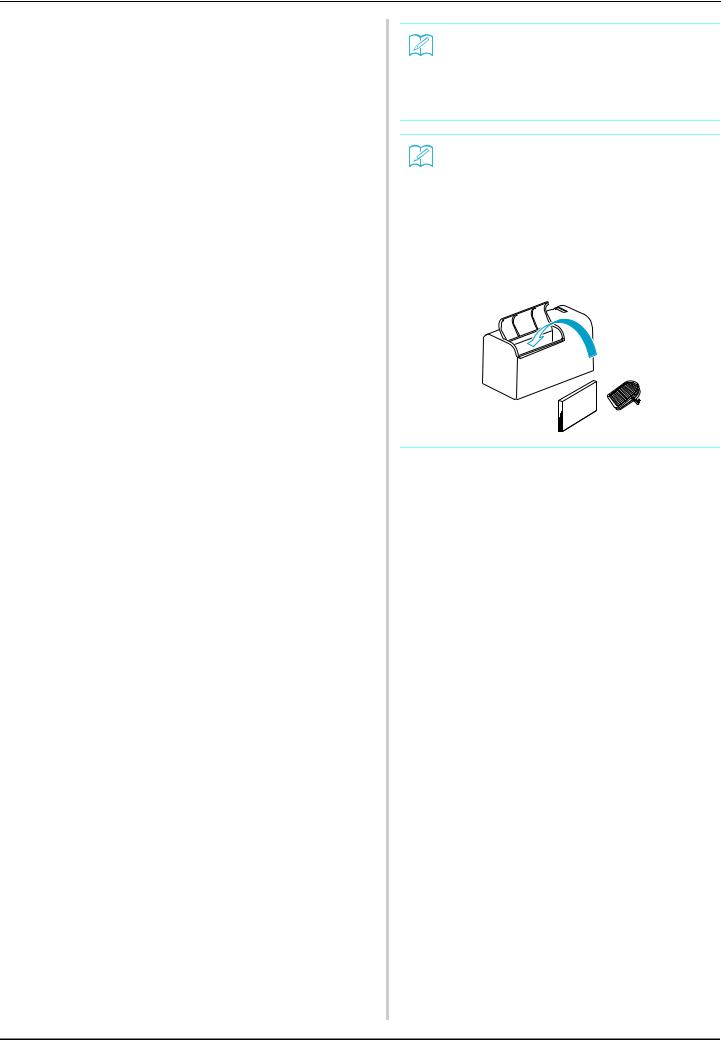
NAMES OF MACHINE PARTS AND THEIR FUNCTIONS
|
|
|
|
Part Code |
No. |
Part Name |
|
|
|
U.S.A./ |
|
Others |
||
|
|
Canada |
|
|
|
|
|
|
|
|
|
|
|
|
1 |
Buttonhole foot “A” |
|
|
X57789-151 |
|
|
|
|
|
2 |
Embroidery foot “W” |
|
XC8156-451 |
|
|
|
|
|
|
3 |
Overcasting foot “G” |
|
XC3098-051 |
|
|
|
|
|
|
4 |
Monogramming foot “N” |
|
X53840-351 |
|
|
|
|
|
|
5 |
Zipper foot “I” |
|
X59370-051 |
|
|
|
|
|
|
6 |
Zigzag foot “J” (on machine) |
|
XC3021-051 |
|
|
|
|
|
|
7 |
Blind stitch foot “R” |
|
X56409-051 |
|
|
|
|
|
|
8 |
Button fitting foot “M” |
|
130489-001 |
|
|
|
|
|
|
9 |
Walking foot |
SA140 |
|
F033N:XC2214-102 |
|
|
|
|
|
10 |
Side cutter foot |
SA177 |
|
F054:XC3879-002 |
|
|
|
|
|
11 |
Free-motion quilting foot |
SA129 |
|
F005N:XC1948-002 |
|
|
|
|
|
12 |
Straight stitch foot |
SA167 |
|
F042N:XC1973-102 |
|
|
|
|
|
13 |
Seam ripper |
|
|
X54243-001 |
|
|
|
|
|
14 |
Bobbin × 10 |
SA156 |
|
SFB:XA5539-151 |
|
|
|
|
|
15 |
Needle set |
|
|
X58358-051 |
|
|
|
|
|
16 |
Twin needle |
|
X59296-151 |
|
|
|
|
|
|
17 |
Ball point needle set |
|
XD0705-051 |
|
|
|
|
|
|
18 |
Scissors |
|
XC1807-121 |
|
|
|
|
|
|
19 |
Chalk pen |
|
184944-001 |
|
|
|
|
|
|
20 |
Cleaning brush |
|
X59476-051 |
|
|
|
|
|
|
21 |
Eyelet punch |
|
135793-001 |
|
|
|
|
|
|
22 |
Screwdriver (large) |
|
X55467-051 |
|
|
|
|
|
|
23 |
Screwdriver (small) |
|
X55468-051 |
|
|
|
|
|
|
24 |
Spool cap (small) |
|
130013-154 |
|
|
|
|
|
|
25 |
Spool cap (medium) × 2 |
|
X55260-153 |
|
|
|
|
|
|
26 |
Spool cap (large) |
|
130012-054 |
|
|
|
|
|
|
27 |
Vertical spool pin |
|
XC8619-051 |
|
|
|
|
|
|
28 |
Spool felt |
|
X57045-051 |
|
|
|
|
|
|
29 |
Disc-shaped screwdriver |
|
XC1074-051 |
|
|
|
|
|
|
30 |
Spool net |
|
XA5523-050 |
|
|
|
|
|
|
31 |
Embroidery frame set (small) |
SA437 |
|
EF73:XC8479-052 |
|
H 2 cm × W 6 cm |
|
|
|
|
(H 1 inch × W 2-1/2 inches) |
|
|
|
|
|
|
|
|
32 |
Embroidery frame set |
SA438 |
|
FE74:XC8480-052 |
|
(medium) H 10 cm × W 10 cm |
|
|
|
|
(H 4 inches × W 4 inches) |
|
|
|
|
|
|
|
|
33 |
Embroidery frame set (large) |
SA439 |
|
EF75:XC8481-052 |
|
H 18 cm × W 13 cm |
|
|
|
|
(H 7 inches × W 5 inches) |
|
|
|
|
|
|
|
|
34 |
Embroidery frame set (extra |
SA440 |
|
EF76:XC8482-052 |
|
large) H 30 cm × W 18 cm |
|
|
|
|
(H 12 inches × W 7 inches) |
|
|
|
|
|
|
|
|
35 |
Foot controller |
XD0500-051 (EU area) |
||
|
|
XC8028-051 (other area) |
||
|
|
|
|
|
36 |
Embroidery needle plate |
|
XA9939-051 |
|
|
cover |
|
|
|
|
|
|
|
|
37 |
Grid sheet set |
SA507 |
|
GS3:X81277-001 |
|
|
|
|
|
38 |
Touch pen (stylus) |
|
|
XA9940-051 |
|
|
|
|
|
39 |
Knee lifter |
|
XA6941-051 |
|
|
|
|
|
|
40 |
USB cable |
|
XC8897-051 |
|
|
|
|
|
|
41 |
Bobbin case (pink screw) |
|
XC8167-151 |
|
|
|
|
|
|
42 |
Straight stitch needle plate |
|
XC8362-051 |
|
|
|
|
|
|
43 |
Cord guide bobbin cover (with |
|
XC8449-051 |
|
|
single hole) |
|
|
|
|
|
|
|
|
44 |
Embroidery bobbin thread |
SA-EBT |
|
EBT-CEN: |
|
|
|
|
X81164-001 |
|
|
|
|
|
45 |
Stabilizer material |
SA519 |
|
BM3:X81175-101 |
|
|
|
|
|
46 |
Operation manual |
|
|
XC8170-151 |
|
|
|
|
|
47 |
Quick reference guide |
|
XC8173-051 |
|
|
|
|
|
|
48 |
Embroidery unit carrying |
SA529 |
|
D6EUC: |
|
case |
|
|
XC9862-052 |
|
|
|
|
|
49 |
Hard case |
|
|
XC7750-051 |
|
|
|
|
|
Memo
(For U.S.A. only)
Foot controller: Model S
This foot controller can be used with this machine model Innov-ís4000D/NV4000D.
Memo
•Always use accessories recommended for this machine.
•The screw of the presser foot holder is available through your authorized dealer (Part code XA4813-051).
•Included accessories 35, 46, and 47 can be stored in the machine’s hard case.
5
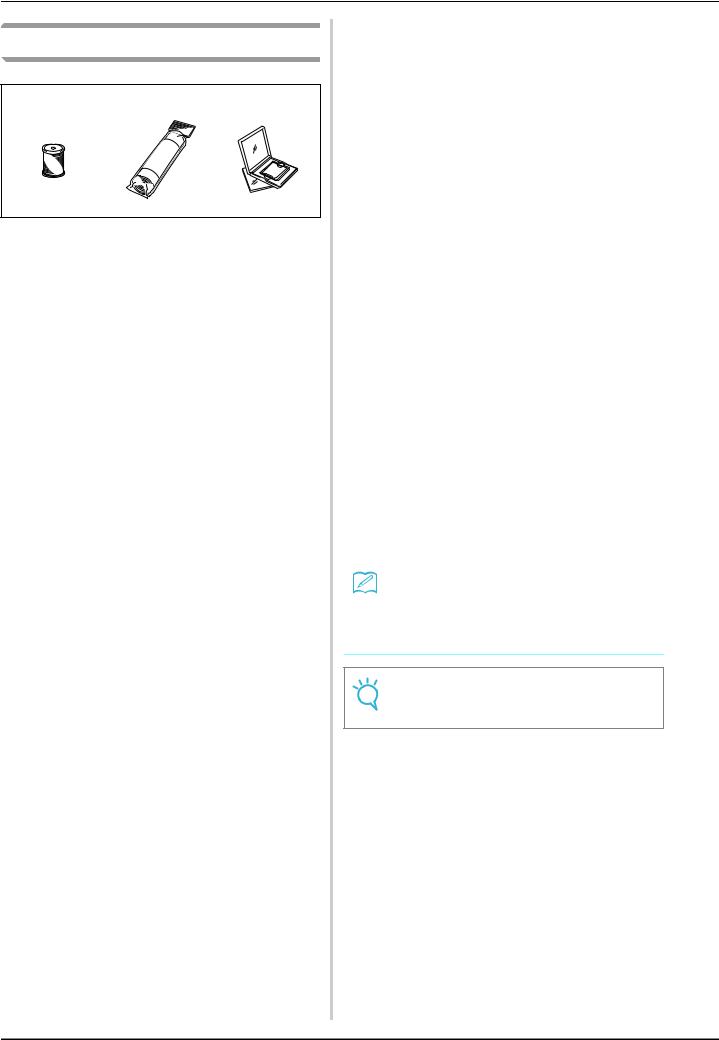
NAMES OF MACHINE PARTS AND THEIR FUNCTIONS
Options
1 |
2 |
3 |
|
|
Part Code |
|
No. |
Part Name |
|
|
U.S.A./ |
Others |
||
|
|
Canada |
|
|
|
|
|
|
|
|
|
1 |
Embroidery bobbin thread |
SA-EBT |
X81164-001 |
|
(White) |
|
|
|
|
|
|
|
Embroidery bobbin thread |
SAEBT999 |
XC5520-001 |
|
(Black) |
|
|
|
|
|
|
2 |
Stabilizer material |
SA519 |
X81175-101 |
|
|
|
|
|
Water soluble stabilizer |
SA520 |
X81267-001 |
|
|
|
|
3 |
Embroidery card |
|
|
|
|
|
|
|
No. 1 Alphabet |
SA298 |
X58317-001 |
|
|
|
|
|
No. 2 Flower |
SA299 |
X58321-001 |
|
|
|
|
|
No. 3 Dinosaur |
SA300 |
X58362-001 |
|
|
|
|
|
No. 6 Moskowitz’s World |
SA303 |
X58497-001 |
|
|
|
|
|
No. 7 Country Life |
SA304 |
X59322-001 |
|
|
|
|
|
No. 8 Holiday |
SA305 |
X59357-001 |
|
|
|
|
|
No. 9 Hobby Craft |
SA306 |
X59511-001 |
|
|
|
|
|
No. 10 Monogram Emblem |
SA307 |
X59567-001 |
|
|
|
|
|
No. 11 Frame |
SA311 |
XA0257-001 |
|
|
|
|
|
No. 12 Transportation |
SA312 |
XA0275-001 |
|
|
|
|
|
No. 13 Sports Emblem |
SA313 |
XA0517-001 |
|
|
|
|
|
No. 14 Large Floral |
SA314 |
XA1223-001 |
|
|
|
|
|
No. 16 Cats & Dogs |
SA316 |
XA1406-001 |
|
|
|
|
|
No. 19 Marine |
SA319 |
XA2452-001 |
|
|
|
|
|
No. 20 Petite Designs |
SA320 |
XA2869-001 |
|
|
|
|
|
No. 21 Needlework |
SA321 |
XA2873-001 |
|
|
|
|
|
No. 22 Large Quilt |
SA322 |
XA3431-001 |
|
|
|
|
|
No. 23 White on White |
SA323 |
XA3430-001 |
|
|
|
|
|
No. 25 Horse |
SA325 |
XA3791-001 |
|
|
|
|
|
No. 27 Birds |
SA327 |
XA4289-001 |
|
|
|
|
|
No. 28 Christmas |
SA328 |
XA4502-001 |
|
|
|
|
|
No. 29 Lace |
SA329 |
XA4664-001 |
|
|
|
|
|
No. 30 Wildlife Animals |
SA330 |
XA4771-001 |
|
|
|
|
|
No. 31 Large Flower II |
SA331 |
XA5037-001 |
|
|
|
|
|
No. 32 Musical Instruments |
SA332 |
XA5386-001 |
|
|
|
|
|
No. 33 Trees |
SA333 |
XA5567-001 |
|
|
|
|
|
No. 35 Cats & Dogs II |
SA335 |
XA5629-001 |
|
|
|
|
|
No. 36 Fruits & Vegetables |
SA336 |
XA5659-001 |
|
|
|
|
|
No. 37 Appliqué Alphabet |
SA337 |
XA5753-001 |
|
|
|
|
|
No. 38 Angel |
SA338 |
XA5781-001 |
|
|
|
|
|
No. 39 Doll Face |
SA339 |
XA5978-001 |
|
|
|
|
|
|
|
Part Code |
|
No. |
Part Name |
|
|
|
U.S.A./ |
|
Others |
||
|
|
Canada |
||
|
|
|
||
|
|
|
|
|
3 |
No. 40 Sports 3 |
SA340 |
|
XA6111-001 |
|
|
|
|
|
|
No. 41 Renaissance Alphabet |
SA341 |
|
XA6586-001 |
|
|
|
|
|
|
No. 42 Farm |
SA342 |
|
XA6733-001 |
|
|
|
|
|
|
No. 43 Victorian |
SA343 |
|
XA6769-001 |
|
|
|
|
|
|
No. 44 Lace2 |
SA344 |
|
XA6849-001 |
|
|
|
|
|
|
No. 45 Fancy Work |
SA345 |
|
XA7770-001 |
|
|
|
|
|
|
No. 46 Australian Animals |
SA346 |
|
XA7893-001 |
|
|
|
|
|
|
No. 47 Butterfly |
SA347 |
|
XA8206-001 |
|
|
|
|
|
|
No. 48 Australian Flowers |
SA348 |
|
XA8250-001 |
|
|
|
|
|
|
No. 49 Folk Art |
SA349 |
|
XA8348-001 |
|
|
|
|
|
|
No. 50 Fairy & Floral |
SA350 |
|
XA8414-001 |
|
|
|
|
|
|
No. 52 Bear Collections |
SA352 |
|
XA8511-001 |
|
|
|
|
|
|
No. 53 Scene |
SA353 |
|
XA8936-001 |
|
|
|
|
|
|
No. 54 Tea Time |
SA354 |
|
XA9129-001 |
|
|
|
|
|
|
No. 55 Gardening |
SA355 |
|
XA9348-001 |
|
|
|
|
|
|
No. 56 Asian |
SA356 |
|
XC0025-001 |
|
|
|
|
|
|
No. 57 Large Christmas |
SA357 |
|
XC0057-001 |
|
|
|
|
|
|
No. 58 New Quilt Traditions |
SA358 |
|
XC0861-001 |
|
|
|
|
|
|
No. 60 Summer Fun |
SA360 |
|
XC1168-001 |
|
|
|
|
|
|
No. 61 Blouse Embellishment |
SA361 |
|
XC1304-001 |
|
|
|
|
|
|
No. 62 Zodiac Signs |
SA362 |
|
XC1502-001 |
|
|
|
|
|
|
No. 63 Bunny |
SA363 |
|
XC1646-001 |
|
|
|
|
|
|
No. 64 Grand Mom |
SA364 |
|
XC2176-001 |
|
|
|
|
|
|
No. 65 Red Work |
SA365 |
|
XC4220-001 |
|
|
|
|
|
|
No. 66 Pop Mix |
SA366 |
|
XC4819-001 |
|
|
|
|
|
|
No. 67 Home Dec Collection |
SA367 |
|
XC7048-001 |
|
|
|
|
|
|
No. 68 Cross Stitch |
SA368 |
|
XC7097-001 |
|
Collection1 |
|
|
|
|
|
|
|
|
|
No. 69 Sport Shirt Motifs |
SA369 |
|
XC7274-001 |
|
|
|
|
|
|
No. 70 Cross Stitch |
SA370 |
|
XC7550-001 |
|
Collection2 |
|
|
|
|
|
|
|
|
|
|
|
|
|
Memo
•You can use any of the brother embroidery cards listed above with your machine.
•Please be aware that some specifications may change without notice.
Note
•Embroidery cards purchased in foreign countries may not work with your machine.
6
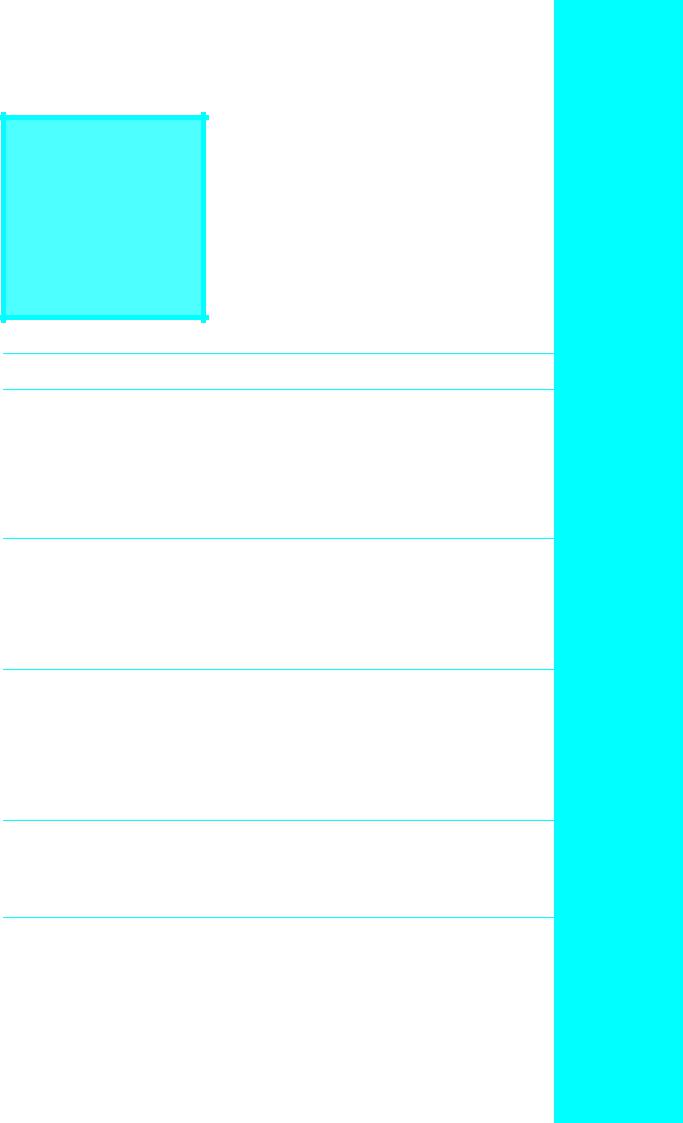
Chapter 1
Getting Ready
TURNING THE MACHINE ON/OFF...................................................... |
8 |
LCD SCREEN.......................................................................................... |
9 |
■ Key Functions .................................................................................................................. |
10 |
Using the Machine Setting Mode Key...................................................................... |
12 |
■ Adjusting Screen Brightness ............................................................................................ |
15 |
■ Choosing the Display Language....................................................................................... |
16 |
Using the Machine Operation Mode Key ................................................................ |
17 |
Using the Pattern Explanation Key .......................................................................... |
18 |
LOWER THREADING .......................................................................... |
19 |
Winding the Bobbin ................................................................................................ |
19 |
■ Using the Supplemental Spool Pin................................................................................... |
19 |
■ Using the Spool Pin ......................................................................................................... |
21 |
Setting the Bobbin................................................................................................... |
22 |
Pulling Up the Bobbin Thread ................................................................................. |
23 |
UPPER THREADING............................................................................ |
25 |
Threading Using the “Automatic Threading” Button............................................... |
25 |
Threading Manually ................................................................................................ |
27 |
Using the Twin Needle Mode.................................................................................. |
29 |
Using Threads that Unwind Quickly ....................................................................... |
31 |
■ Using the Spool Net ........................................................................................................ |
31 |
■ Using the Vertical Spool Pin............................................................................................ |
31 |
CHANGING THE PRESSER FOOT ....................................................... |
32 |
Removing the Presser Foot ...................................................................................... |
32 |
Attaching the Presser Foot ...................................................................................... |
32 |
Attaching the Walking Foot..................................................................................... |
33 |
CHANGING THE NEEDLE ................................................................... |
34 |
■ About the Needle ............................................................................................................ |
36 |
■ Fabric/Thread/Needle Combinations .............................................................................. |
36 |
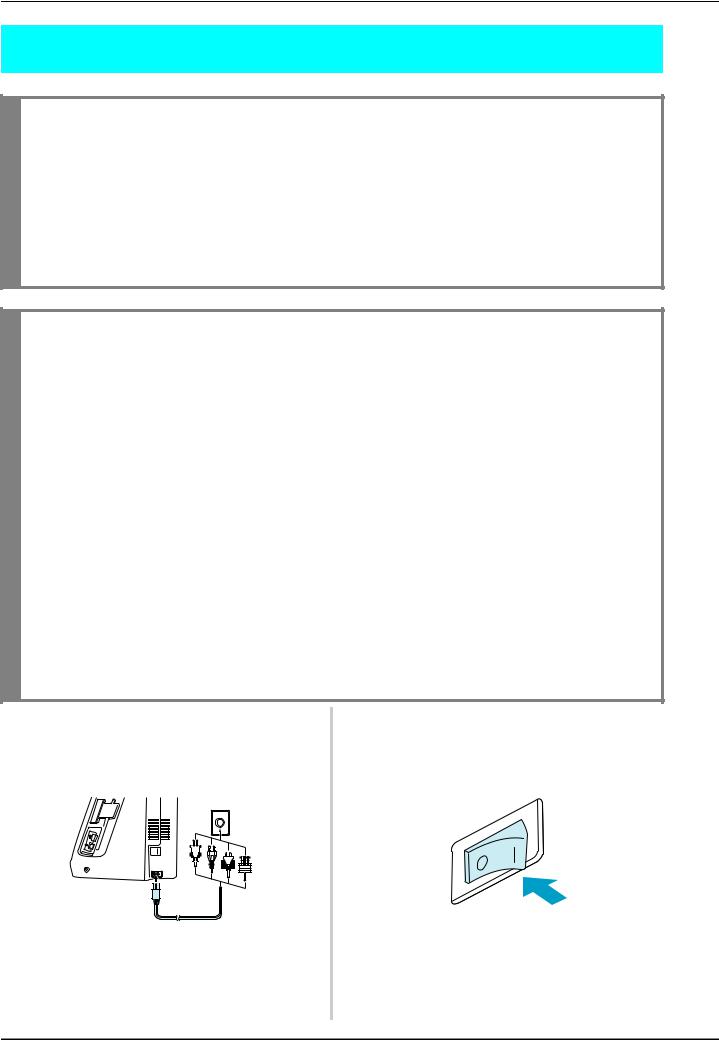
TURNING THE MACHINE ON/OFF
TURNING THE MACHINE ON/OFF
 WARNING
WARNING
•Use only regular household electricity as the power source. Using other power sources may result in fire, electric shock, or damage to the machine.
•Turn the main power to OFF and remove the plug in the following circumstances: When you are away from the machine
After using the machine
When the power fails during use
When the machine does not operate correctly due to a bad connection or a disconnection During electrical storms
 CAUTION
CAUTION
•Do not use extension cords or multi-plug adapters with many other appliances plugged in to them. Fire or electric shock may result.
•Do not touch the plug with wet hands. Electric shock may result.
•When unplugging the machine, always turn the main power to OFF first. Always grasp the plug to remove it from the outlet. Pulling on the cord may damage the cord, or lead to fire or electric shock.
•Do not allow the power cord to be cut, damaged, modified, forcefully bent, pulled, twisted, or bundled. Do not place heavy objects on the cord. Do not subject the cord to heat. These things may damage the cord, or cause fire or electric shock. If the cord or plug is damaged, take the machine to your authorized dealer for repairs before continuing use.
•Unplug the power cord if the machine is not to be used for a long period of time. Otherwise, a fire may result.
•When leaving the machine unattended, either the main switch of the machine should be turned to OFF or the plug must be removed from the socket-outlet.
•When servicing the machine or when removing covers, either the machine or the electrical set must be unplugged.
•For U.S.A. only
This appliance has a polarized plug (one blade wider than the other). To reduce the risk of electrical shock, this plug is intended to fit in a polarized outlet only one way.
If the plug does not fit fully in the outlet, reverse the plug. If it still does not fit, contact a qualified electrician to install the proper outlet. Do not modify the plug in any way.
aInsert the power cord into the power cord jack connector, then insert the plug into a wall outlet.
a
b
aMain power switch
bPower cord
bTurn the main power switch to “I” to turn on the machine.
b
a
aOFF
bON
cTurn the main power switch to “O” to turn off the machine.
8
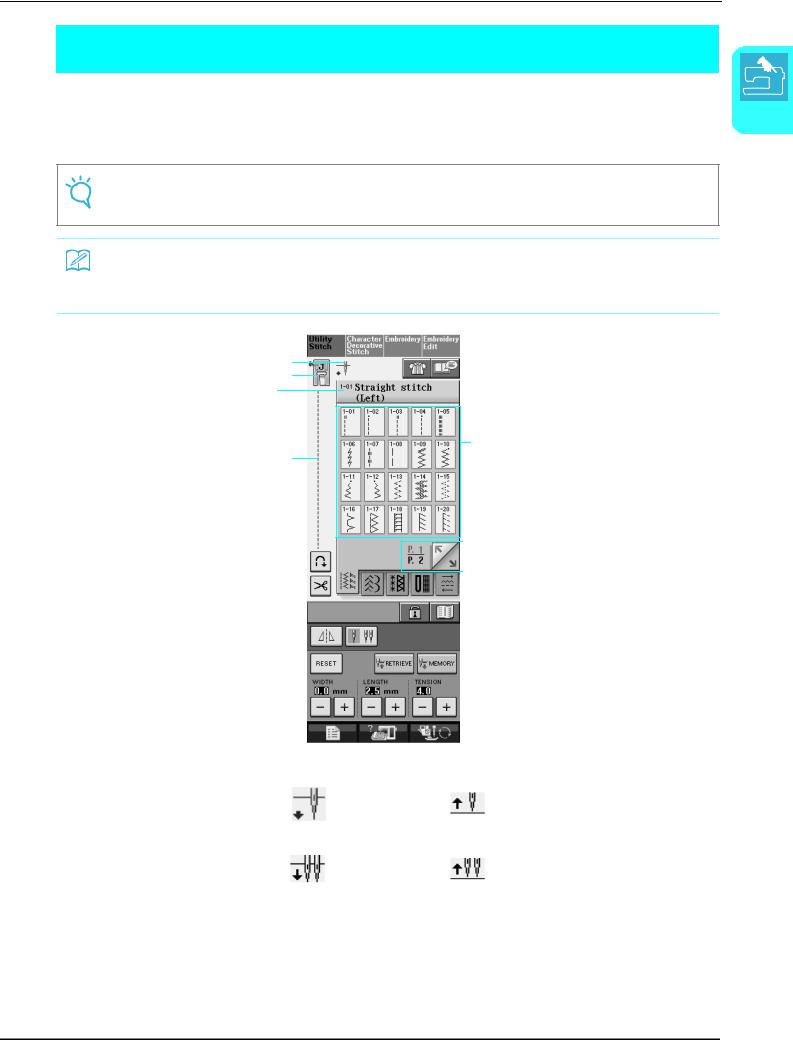
LCD SCREEN
LCD SCREEN
When switching on the machine, the screen will display the name of the machine. Touch the screen to display the utility stitch. Either “1-01 Straight stitch (Left)” or “1-03 Straight stitch (Middle)” is selected, depending on the setting selected in the setting screen (See page 12).
Press a key with your finger to select the stitch pattern, to select a machine function, or to select an operation indicated on the key.
Note
When the straight stitch needle plate is on the machine, the needle will automatically move to the middle position.
Memo
•Only touch the screen with your finger or the included touch pen. Do not use a sharp pencil, screwdriver, or other hard or sharp object. It is not necessary to press hard on the screen. Pressing too hard or using a sharp object may damage the screen.
a b
c
e
d
 f
f
1
Ready Getting
a Shows single or twin needle mode setting, and the needle stop position.
Single needle/down position |
Single needle/up position |
Twin needle/down position |
Twin needle/up position |
bShows the presser foot code. Attach the presser foot indicated in this display before sewing.
cShows the name and code number of the selected stitch.
dShows a preview of the selected stitch.
eShows the stitch patterns.
fShows additional pages that can be displayed.
*All key functions of the LCD are explained in the “key functions” table on the following page.
9
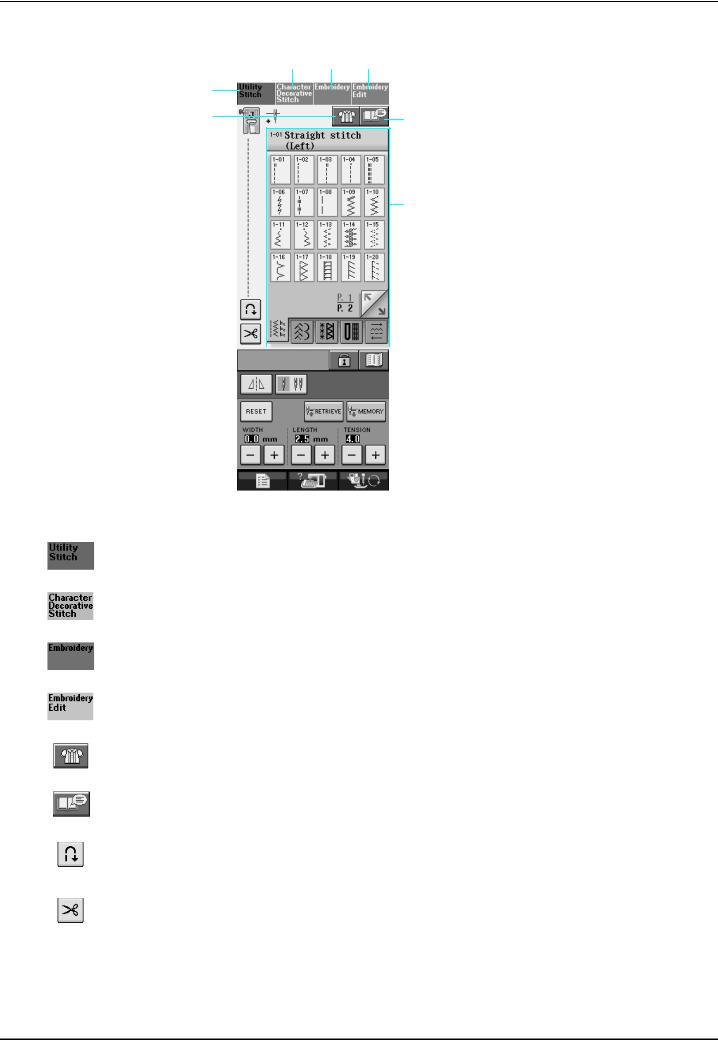
LCD SCREEN
■ Key Functions
b c d
a
e f
i
|
|
g |
|
|
|
|
|
|
|
|
|
|
|
|
|
|
|
|
|
|
|
|
|
|
|
|
|
|
|
|
|
|
|
|
|
|
|
|
|
h |
|
|
|
|
|
|
|
|
|
|
|
|
|
|
|
|
|
|
|
|
|
|
|
|
|
|
|
|
|
|
|
|
|
|
|
|
|
j |
|
|
|
|
|
|
|
|
|
|
|
|
|
k |
|
|
|
|
|
|
|
|
|
|
|
|
|
|
|
|
|
|
|
||
|
|
|
|
|
|
|
|
|
|
|
|
|
|
|
|
|
||
|
|
l |
|
|
|
|
|
|
|
|
|
|
|
|
|
m |
|
|
|
|
|
|
|
|
|
|
|
|
|
|
|
|
|
|
|
||
|
|
|
|
|
|
|
|
|
|
|
|
|
|
|
|
|
||
|
|
n |
|
|
|
|
|
|
|
|
|
|
|
|
|
o |
p |
|
|
|
|
|
|
|
|
|
|
|
|
|
|
|
|
|
|||
|
|
|
|
|
|
|
|
|
|
|
|
|
|
|
|
|||
|
|
|
|
|
|
|
|
|
|
|
|
|
|
|
|
|
||
|
|
q |
|
|
|
|
|
|
|
|
|
|
|
|
|
r |
|
|
|
|
|
|
|
|
|
|
|
|
|
|
|
|
|
|
|
||
|
|
|
|
|
|
|
|
|
|
|
|
|
|
|
|
|
||
|
|
|
|
|
|
|
|
|
|
|
|
|
|
|
|
|||
|
|
|
|
|
|
|
|
|
|
|
|
|
|
|
t |
|
|
|
|
|
s |
|
|
|
|
|
|
|
|
|
|
|
|
|
u |
|
|
|
|
|
|
|
|
|
|
|
|
|
|
|
|
|
|
|||
|
|
|
|
|
|
|
|
|
|
|
|
|
|
|
|
|||
|
|
|
|
|
|
|
|
|
|
|
|
|
|
|
|
|
||
|
|
|
|
|
|
|
|
|
|
|
|
|
|
|
|
|
|
|
No. |
Display |
Key Name |
|
|
|
|
|
|
|
|
|
|
Explanation |
Page |
||||
|
|
|
|
|
|
|
|
|
|
|
|
|
|
|
|
|
|
|
a |
|
Utility stitch key |
Press this key to select a straight stitch, zigzag stitch, buttonhole, blind hem |
48 |
||||||||||||||
|
|
|
|
stitch, or other stitches commonly used in garment construction. |
|
|||||||||||||
|
|
|
|
|
|
|
|
|
|
|
|
|
|
|
|
|
|
|
b |
|
Character/Decorative |
Press this key to select character or decorative stitch patterns. |
98 |
||||||||||||||
|
|
stitch key |
|
|
|
|
|
|
|
|
|
|
|
|
|
|
|
|
|
|
|
|
|
|
|
|
|
|
|
|
|
|
|
|
|
|
|
c |
|
Embroidery key |
Attach the embroidery unit and press this key to sew embroidery. |
130 |
||||||||||||||
|
|
|
|
|
|
|
|
|
|
|
|
|
|
|
|
|
|
|
d |
|
Embroidery edit key |
Press this key to combine embroidery patterns. With the embroidery edit |
177 |
||||||||||||||
|
|
|
|
functions, you can also create original embroidery patterns or frame patterns. |
|
|||||||||||||
|
|
|
|
|
|
|
|
|
|
|
|
|
|
|
|
|
|
|
e |
|
Sewing type selection |
Press this key when you need help selecting the appropriate stitch pattern for |
51 |
||||||||||||||
|
|
key |
the sewing application and when you need instructions on how to sew the stitch |
|
||||||||||||||
|
|
|
|
pattern. This key is very helpful for beginners. |
|
|||||||||||||
|
|
|
|
|
|
|
|
|
|
|
|
|
|
|
|
|
|
|
f |
|
Pattern explanation |
Press this key to see an explanation of the selected pattern. |
18 |
||||||||||||||
|
|
key |
|
|
|
|
|
|
|
|
|
|
|
|
|
|
|
|
|
|
|
|
|
|
|
|
|
|
|
|
|
|
|
|
|
|
|
g |
|
Automatic |
Press this key to use the automatic reinforcement stitching (reverse stitching) |
44 |
||||||||||||||
|
|
reinforcement stitch |
setting. If you select this setting before sewing, the machine will automatically |
|
||||||||||||||
|
|
key |
sew reinforcement stitches at the beginning and end of sewing (depending on |
|
||||||||||||||
|
|
|
|
the pattern, the machine may sew reverse stitches). |
|
|||||||||||||
|
|
|
|
|
|
|
|
|
|
|
|
|
|
|
|
|
|
|
h |
|
Automatic thread |
Press this key to set the automatic thread cutting function. Set the automatic |
45 |
||||||||||||||
|
|
cutting key |
thread cutting function before sewing to have the machine automatically sew |
|
||||||||||||||
|
|
|
|
reinforcement stitches at the beginning and end of sewing (depending on the |
|
|||||||||||||
|
|
|
|
pattern, the machine may sew reverse stitches) and trim the threads after |
|
|||||||||||||
|
|
|
|
sewing. |
|
|
||||||||||||
|
|
|
|
|
|
|
|
|
|
|
|
|
|
|
|
|
|
|
10
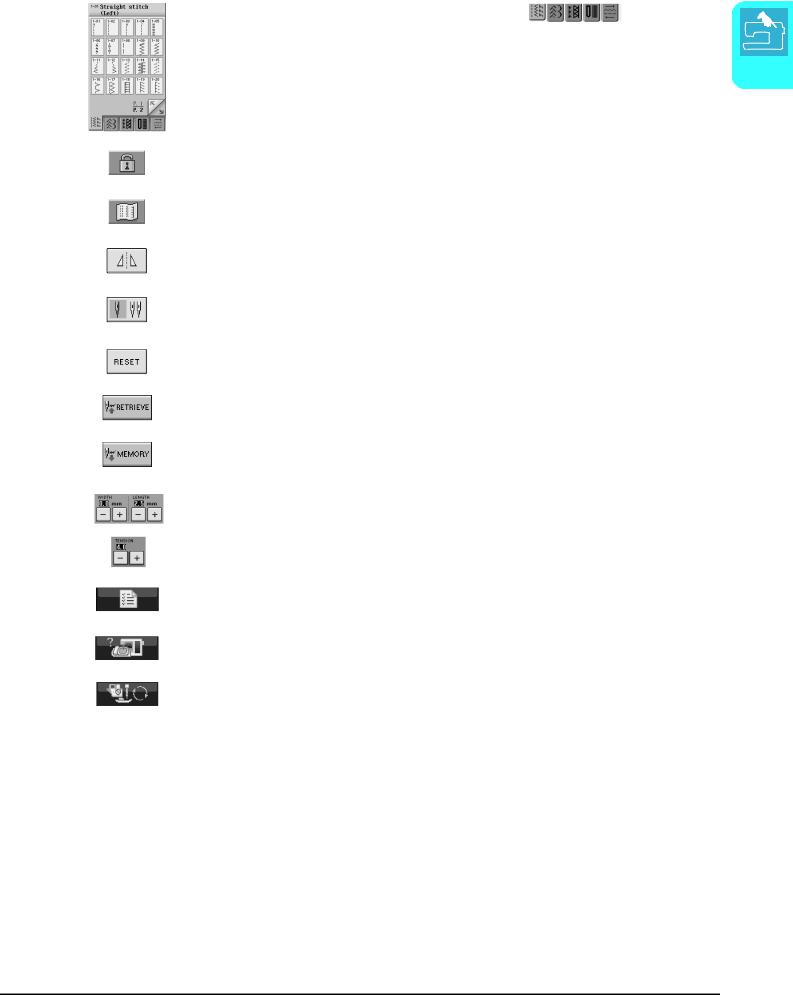
|
|
|
|
|
LCD SCREEN |
||
|
|
|
|
|
|
|
|
|
No. |
Display |
Key Name |
Explanation |
|
Page |
|
|
|
|
|
|
|
|
|
|
i |
|
Stitch selection |
Press the key of the pattern you want to sew. Use |
to |
48 |
|
|
|
|
display |
|
|
||
|
|
|
|
|
|
|
|
|
|
|
|
change selection screens. |
|
|
|
|
|
|
|
|
|
|
|
|
j |
|
Screen lock key |
Press this key to lock the screen.When the screen is locked, the various |
|
46 |
|
|
|
|
|
settings, such as the stitch width and stitch length, are locked and cannot be |
|
|
|
|
|
|
|
changed. Press this key again to unlock the settings. |
|
|
|
|
|
|
|
|
|
|
|
|
k |
|
Image key |
Press this key to display an enlarged image of the selected stitch pattern. |
49 |
|
|
|
|
|
|
|
|
|
|
|
l |
|
Mirror image key |
Press this key to create a mirror image of the selected stitch pattern. If the key |
49 |
|
|
|
|
|
|
display is light gray, a mirror image of the selected stitch pattern cannot be |
|
|
|
|
|
|
|
sewn. |
|
|
|
|
|
|
|
|
|
|
|
|
m |
|
Needle mode |
Press this key to select twin needle sewing mode. The sewing mode changes |
29 |
|
|
|
|
|
selection key (single/ |
between single needle mode and twin needle mode each time you press the |
|
|
|
|
|
|
double) |
key. If the key display is light gray, the selected stitch pattern cannot be sewn in |
|
|
|
|
|
|
|
twin needle mode. |
|
|
|
|
|
|
|
|
|
|
|
|
n |
|
Reset key |
Press this key to return the selected stitch pattern’s saved settings to the |
|
42-43 |
|
|
|
|
|
original settings. |
|
|
|
|
|
|
|
|
|
|
|
|
o |
|
Retrieve key |
Press this key to retrieve a saved pattern. |
|
51 |
|
|
|
|
|
|
|
|
|
|
p |
|
Manual memory key |
Change the stitch pattern settings (zigzag width and stitch length, thread |
|
50 |
|
|
|
|
|
tension, automatic thread cutting or automatic reinforcement stitching, etc.), |
|
|
|
|
|
|
|
then save them by pressing this key. Five sets of settings can be saved for a |
|
|
|
|
|
|
|
single stitch pattern. |
|
|
|
|
|
|
|
|
|
|
|
|
q |
|
Stitch width and stitch |
Shows the zigzag width and stitch length settings of the currently selected stitch |
42 |
|
|
|
|
|
length key |
pattern. You can use the plus and minus keys to adjust the zigzag width and |
|
|
|
|
|
|
|
stitch length settings. |
|
|
|
|
|
|
|
|
|
|
|
|
r |
|
Thread tension key |
Shows the thread tension setting of the currently selected stitch pattern. The |
43 |
|
|
|
|
|
|
thread tension is usually set automatically. You can use the plus and minus keys |
|
|
|
|
|
|
|
to change the thread tension settings. |
|
|
|
|
|
|
|
|
|
|
|
|
s |
|
Machine setting mode |
Press this key to change the needle stop position, turn the buzzer ON/OFF, |
12 |
|
|
|
|
|
key |
adjust the pattern or screen, and change other machine settings. |
|
|
|
|
|
|
|
|
|
|
|
|
t |
|
Machine operation |
Press this key to see explanations for upper threading, winding the bobbin, |
17 |
|
|
|
|
|
mode key |
changing the presser foot, and how to use the machine. |
|
|
|
|
|
|
|
|
|
|
|
|
u |
|
Presser foot/Needle |
Press this key before changing the needle, the presser foot, etc. This key locks |
32-35 |
|
|
|
|
|
exchange key |
all key and button functions to prevent operation of the machine. |
|
|
|
|
|
|
|
|
|
|
|
1
Ready Getting
11
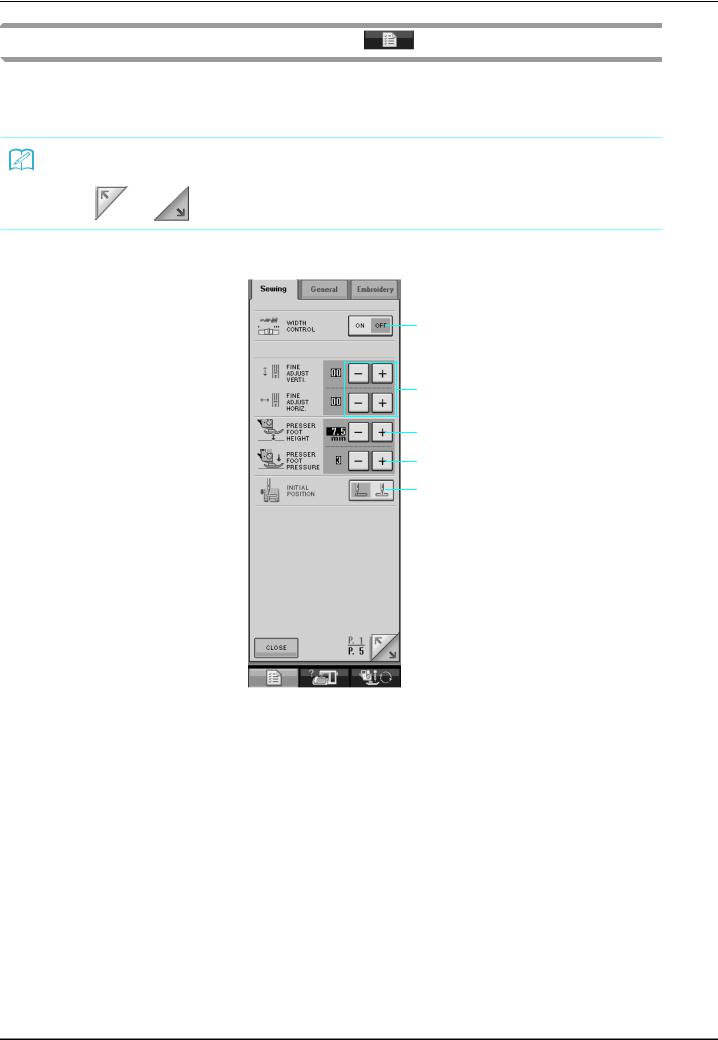
LCD SCREEN
Using the Machine Setting Mode Key
Press  to change the default machine settings (needle stop position, embroidery speed, opening display, etc.) Press
to change the default machine settings (needle stop position, embroidery speed, opening display, etc.) Press  ,
,  or
or  to display the different settings screens.
to display the different settings screens.
Memo
• This function will be available in future technology upgrades.
• Press |
or |
to display a different settings screen. |
Sewing settings
a
b
c d e
aSelect whether to use the sewing speed controller to determine the zigzag width (see page 70).
bMake adjustments to character or decorative stitch patterns (see page 103).
cAdjust the presser foot height. (Select the height of the presser foot when the presser foot is raised.)
dAdjust the presser foot pressure. (The higher the number, the higher the pressure will be. Set the pressure at 3 for normal sewing.)
eSelect whether “1-01 Straight stitch (Left)” or “1-03 Straight stitch (Middle)” is the utility stitch that is automatically selected when the machine is turned on.
12

LCD SCREEN
General settings
|
|
|
a |
|
|
|||
|
|
|
|
|
||||
|
|
|
|
b |
|
|
||
|
|
|
|
|
|
|||
|
|
|
c |
|
|
|||
|
|
|
|
|
||||
|
|
|
d |
|
|
|||
|
|
|
|
|
||||
|
|
|
|
|
||||
|
|
|
|
e |
|
h |
||
|
|
|
|
|
||||
|
|
|
|
|
||||
|
|
|
|
f |
|
|
||
|
|
|
|
|
||||
|
|
|
|
|||||
|
|
|
|
|
|
|
|
i |
|
|
|
|
|
|
|
|
|
|
|
|
|
g |
|
|||
|
|
|
|
|
j |
|||
|
|
|
|
|
|
|
|
|
aChange the brightness of the LCD (see page 15).
bSelect the needle stop position (the needle position when the machine is not operating) to be up or down.
cTurn the buzzer ON/OFF.
dTurn the Needle Area and Work Area Lights ON/OFF.
eTurn the opening screen display ON/OFF.
fUse when running an application.
gChange the display language (see page 16).
hDisplay the service count and the total number of embroidery stitches. The service count is a reminder to take your machine in for regular servicing. (Contact your authorized dealer for details.)
iThe “NO.” is the number for the embroidery and sewing machine.
jDisplay the program version.
Memo
The latest version of software is installed in your machine. Check with your local authorized Brother dealer or at www.brother.com for notification of available updates (see page 224).
1
Ready Getting
13
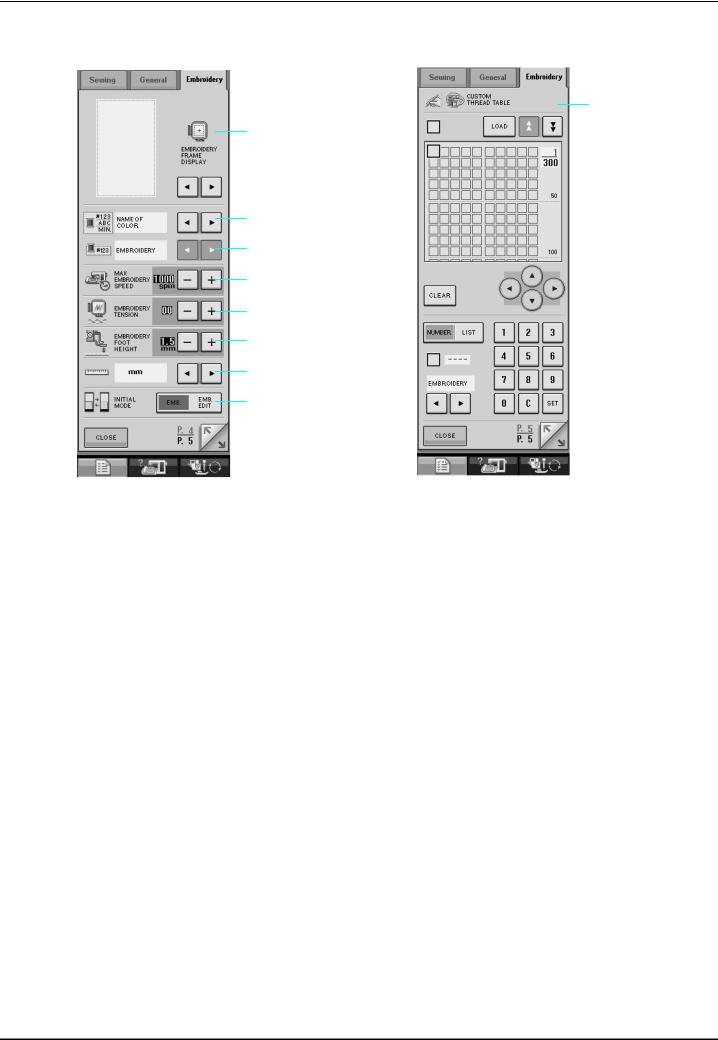
LCD SCREEN
Embroidery settings
i
a
b c d e f g h
aSelect from among 10 embroidery frame displays (see page 158).
bChange the thread color display on the embroidery screen; thread number, color name or each time to embroider (see page 156).
cWhen the thread number #123 is selected, select among six thread brands (see page 156).
dAdjust the maximum embroidery speed setting (see page 156).
eAdjust the thread tension for embroidering.
fSelect the height of the embroidery foot “W” during embroidering (see page 138).
gChange the display units (mm/inch).
hChange the initial mode of the display (embroidery/embroidery edit).
iCustomize the thread color numbers (see page 188).
14
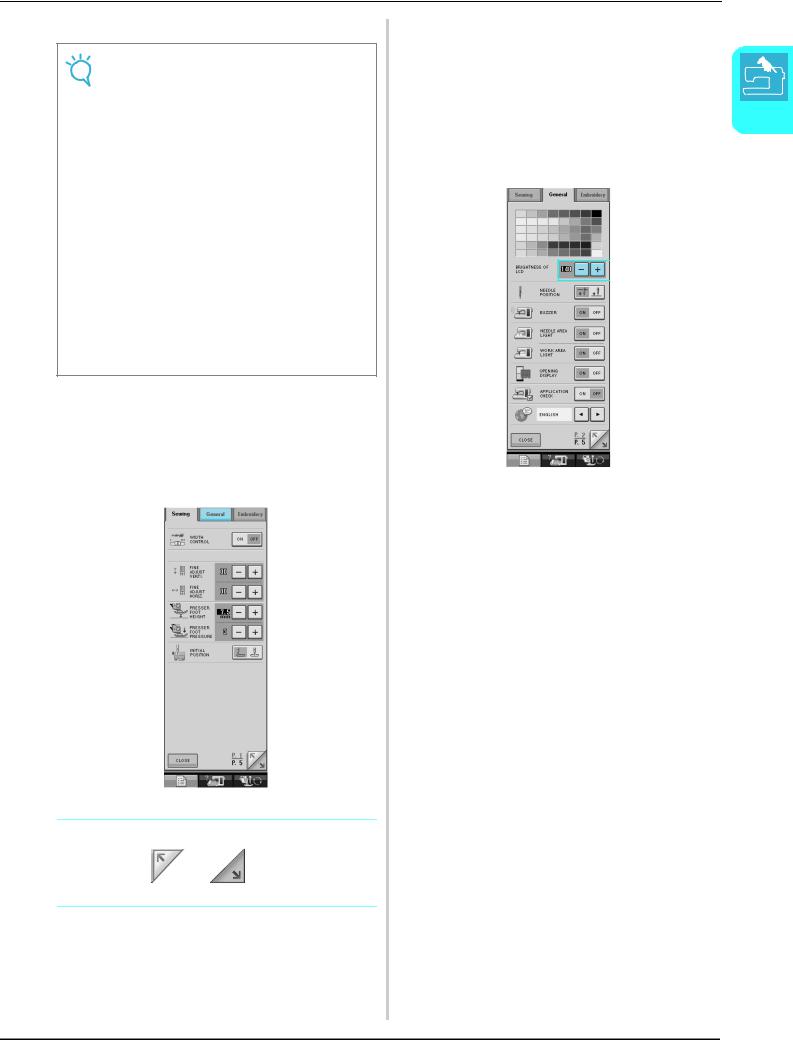
LCD SCREEN
■ Adjusting Screen Brightness
Note
•All or part of the screen may sometimes become darker or lighter because of changes in the air temperature or other changes in the environment around the screen. This is normal and is not a sign of malfunction. Adjust the screen if it is difficult to read.
•The screen may be dark immediately after turning on the power. This is a function of the LCD back light screen, and it is not a sign of malfunction. The screen will return to its normal level of brightness after approximately 10 minutes.
•If you are not directly in front of the machine when you view the LCD, the colors may appear to change or the screen may be difficult to see. This is a characteristic of the LCD, and not a sign of damage or malfunction. For best results operate the screen while sitting in front of the machine.
aPress  .
.
→The Sewing settings screen appears.
bPress  .
.
cOn the BRIGHTNESS OF LCD display, use
 and
and  to adjust the screen brightness.
to adjust the screen brightness.
*Press  to make the screen darker.
to make the screen darker.
* Press  to make the screen lighter.
to make the screen lighter.

 a
a
a Brightness of LCD display
dPress  .
.
→ The General settings screen appears.
 Memo
Memo
• Press or to display a different
settings screen.
1
Ready Getting
15
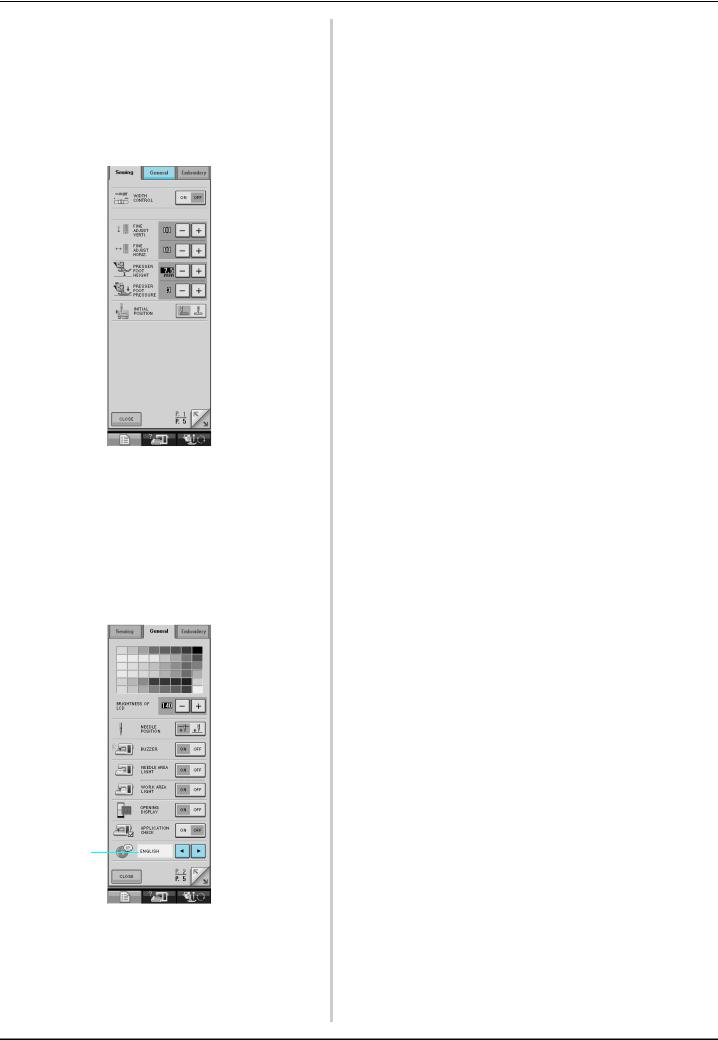
LCD SCREEN
■ Choosing the Display Language
aPress  .
.
→The Sewing settings screen appears.
bPress  .
.
→ The General settings screen appears.
cUse  and
and  to choose the display language.
to choose the display language.
*Choose from the following languages: [ENGLISH], [GERMAN], [FRENCH], [ITALIAN], [DUTCH], [SPANISH], [DANISH], [FINNISH], [SWEDISH], [PORTUGEUSE], [RUSSIAN], [NORWEGIAN] or [JAPANESE].
a
a Display language
dPress  .
.
16
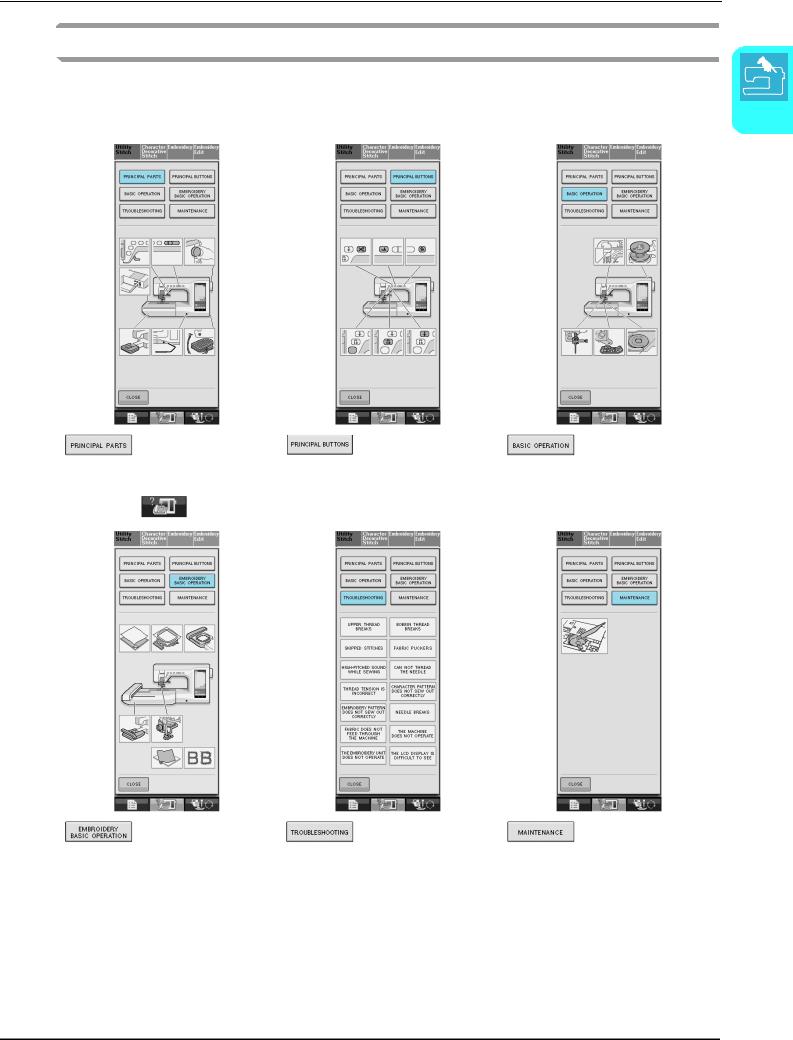
LCD SCREEN
Using the Machine Operation Mode Key 
Press  to open the screen shown below. Six categories are displayed at the top of the screen. Press a key to see more information about that category.
to open the screen shown below. Six categories are displayed at the top of the screen. Press a key to see more information about that category.
|
displays information about |
displays information about |
displays information about |
the main parts of the machine and their |
the operation buttons. |
threading the machine, changing presser feet, |
|
functions. This is the first screen displayed |
|
etc. |
|
when you press |
. |
|
|
|
|
|
|
|
displays information about |
displays troubleshooting |
displays information about |
attaching the embroidery unit, preparing |
information. |
cleaning the machine, etc. |
|
fabric for embroidering, etc. |
|
|
|
|
|
|
|
1
Ready Getting
17
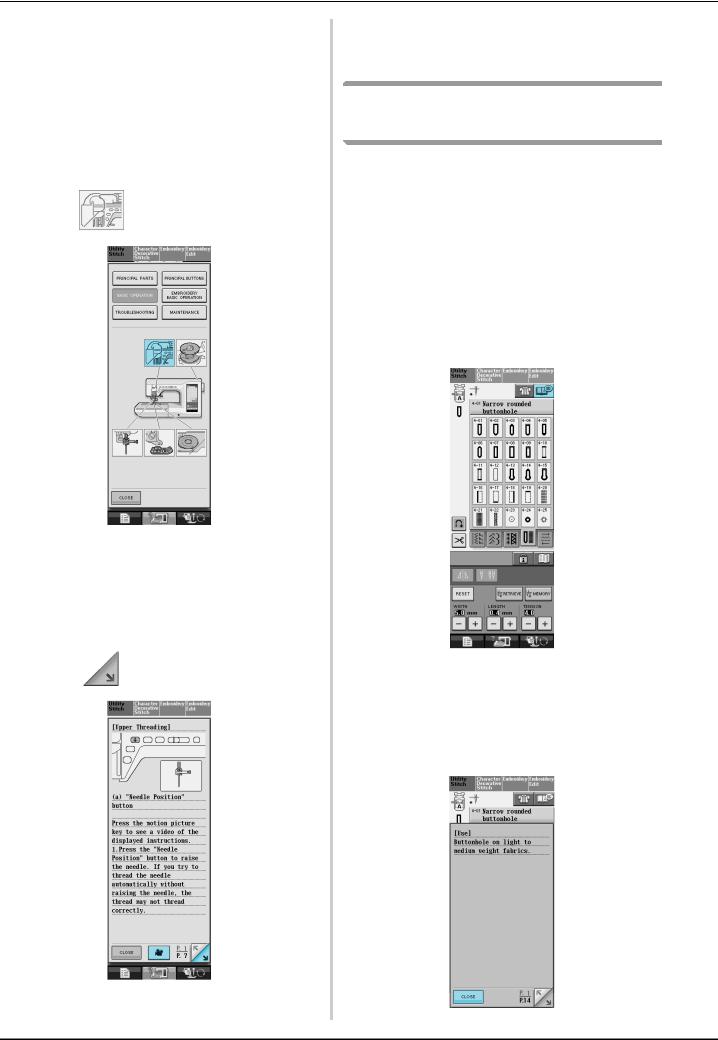
LCD SCREEN
Example: Displaying information about upper threading
aPress  .
.
bPress  .
.
→The lower half of the screen will change.
cPress |
(upper threading). |
→The screen shows instructions for threading the machine.
dRead the instructions.
*Press  to see a video of the displayed instructions.
to see a video of the displayed instructions.
* Press |
to view the next page. |
ePress  to return to the original screen.
to return to the original screen.
Using the Pattern Explanation
Key 
If you want to know more about the uses of a stitch pattern, select the pattern and press  to see an explanation of the stitch selection.
to see an explanation of the stitch selection.
Example: Displaying information about
aPress  .
.
bPress  .
.
→ The screen shows information about  .
.
cPress  to return to the original screen.
to return to the original screen.
18
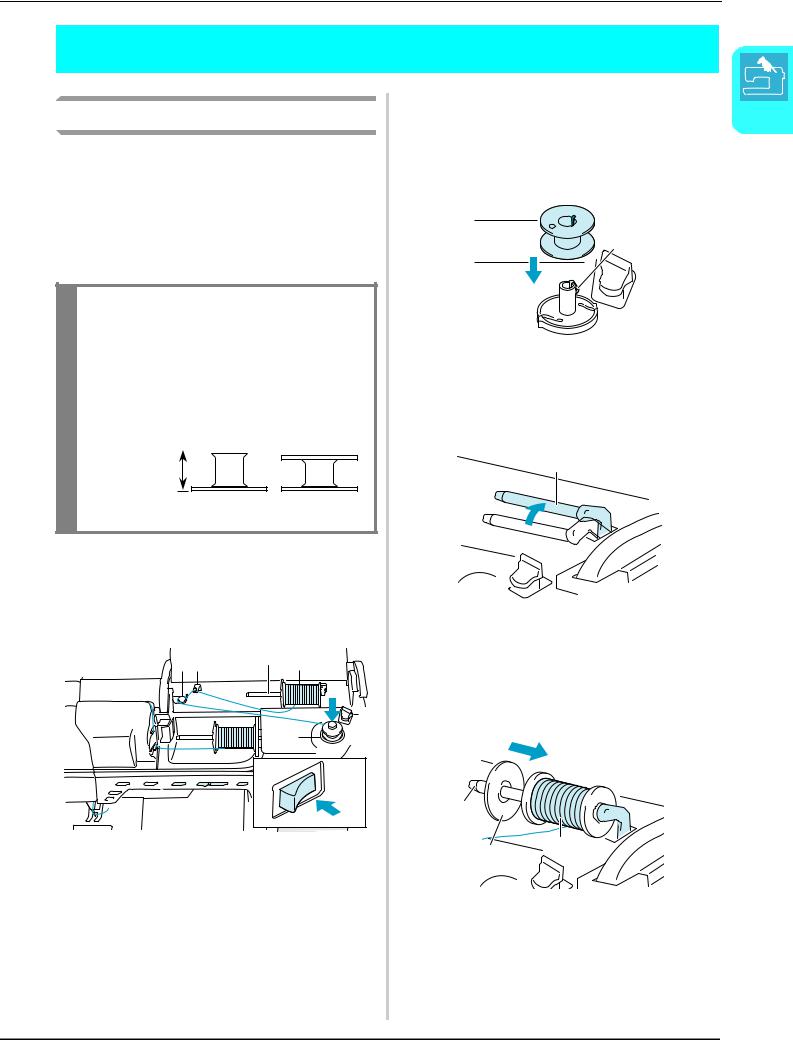
LOWER THREADING
Winding the Bobbin
Press  →
→  →
→  →
→
 in that order to display a video example of
in that order to display a video example of
bobbin winding on the LCD (see page 18). Follow the steps explained below to complete the operation.
 CAUTION
CAUTION
•The enclosed bobbin was designed specifically for this sewing machine. If bobbins from other models are used, the machine will not operate correctly. Use only the enclosed bobbin or bobbins of the same type (part code: SA156, (XA5539-151)).
Actual size 11.5 mm 


(approx. 7/16 inch)
This model |
Other models |
■ Using the Supplemental Spool Pin
With this machine, you can wind the bobbin during sewing. While using the main spool pin to sew embroidery, you can conveniently wind the bobbin using the supplemental spool pin.
6 5 |
a 3, 4 |
|
2 |
|
9 |
|
7, 8 |
|
l |
|
o |
|
1 |
a Supplemental spool pin |
|
LOWER THREADING
aTurn the main power to ON.
bAlign the groove in the bobbin with the spring on the bobbin winder shaft, and set the bobbin on the shaft.
 a
a
b
aGroove of the bobbin
bSpring on the shaft
cSetposition.the supplemental spool pin in the “up”
a
a Supplemental spool pin
dPlace the spool of thread on the supplemental spool pin, so that thread unrolls from the front. Then push the spool cap onto the spool pin as far as possible to secure the thread spool.
a
b c
aSpool pin
bSpool cap
cThread spool
1
Ready Getting
19
